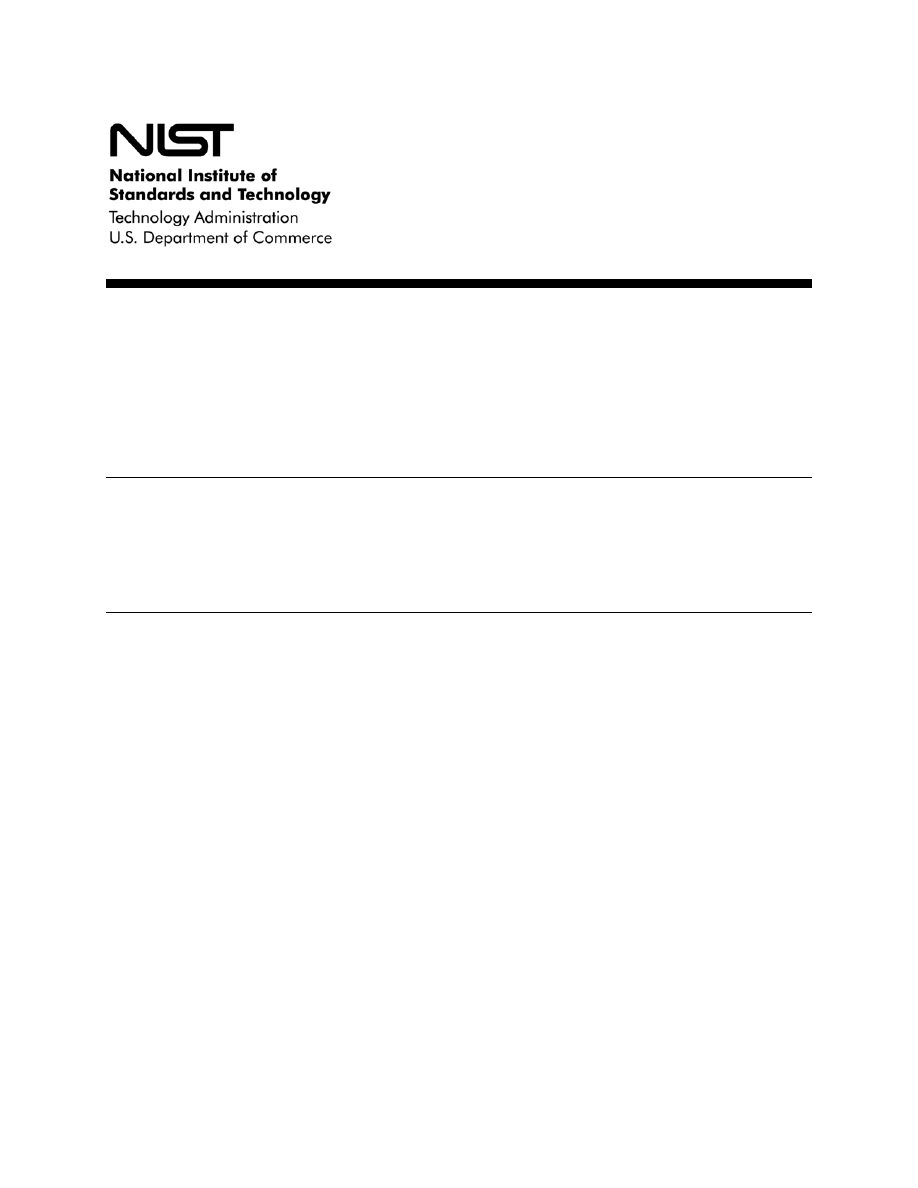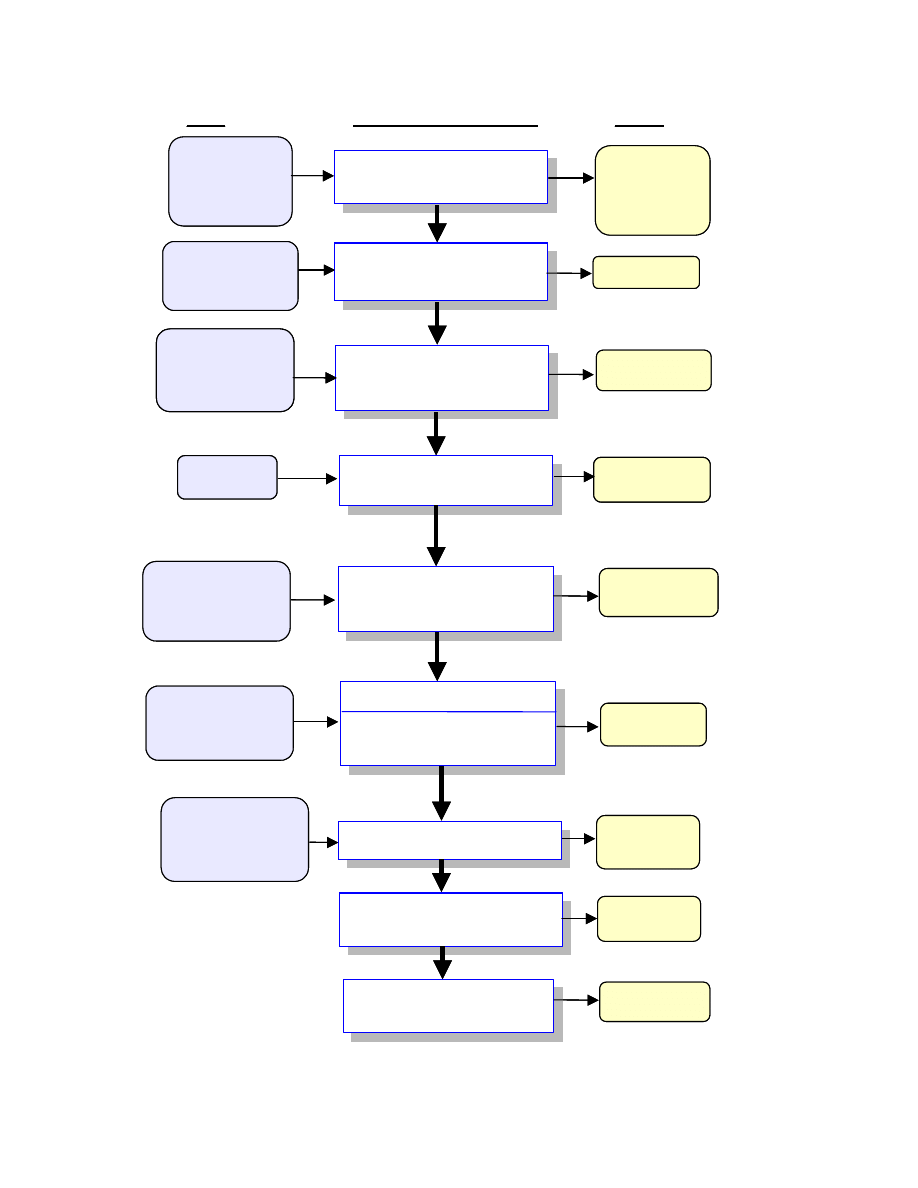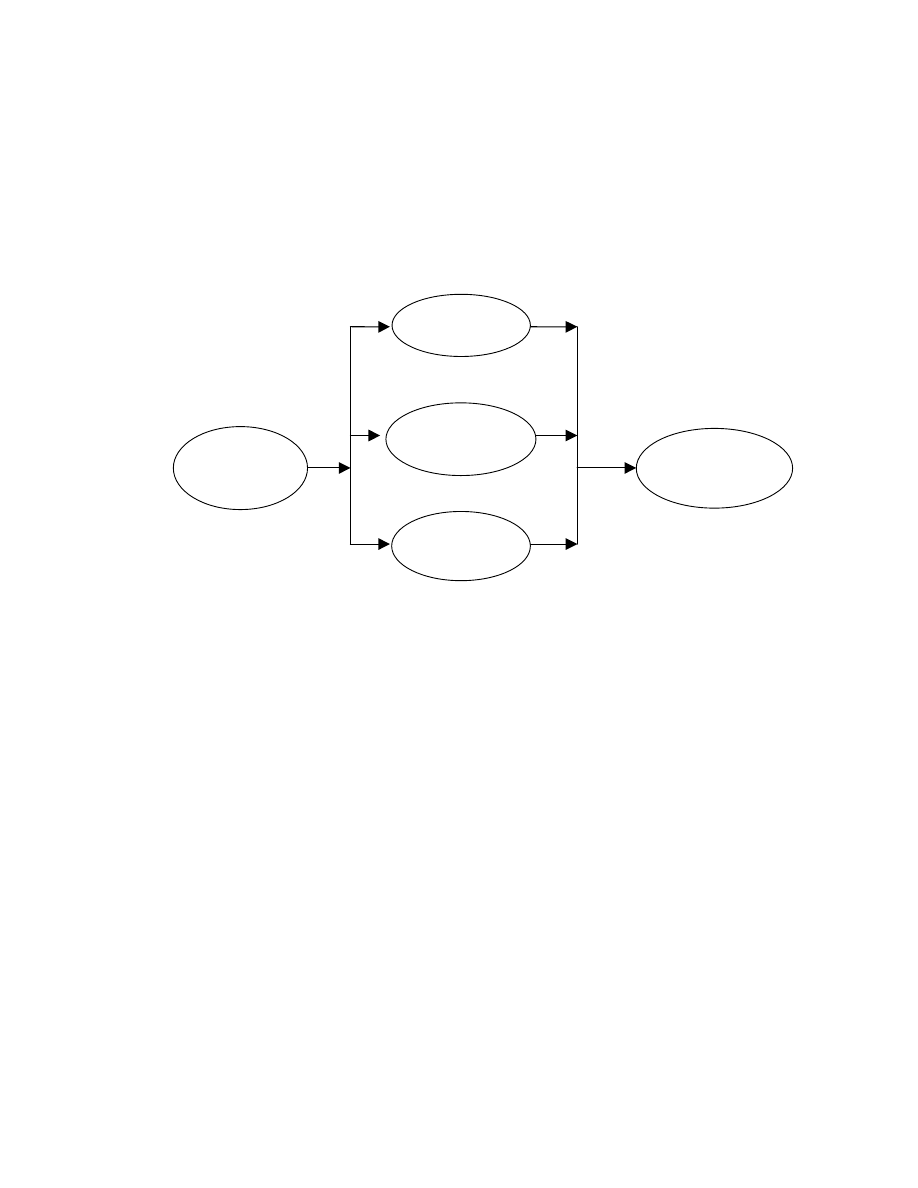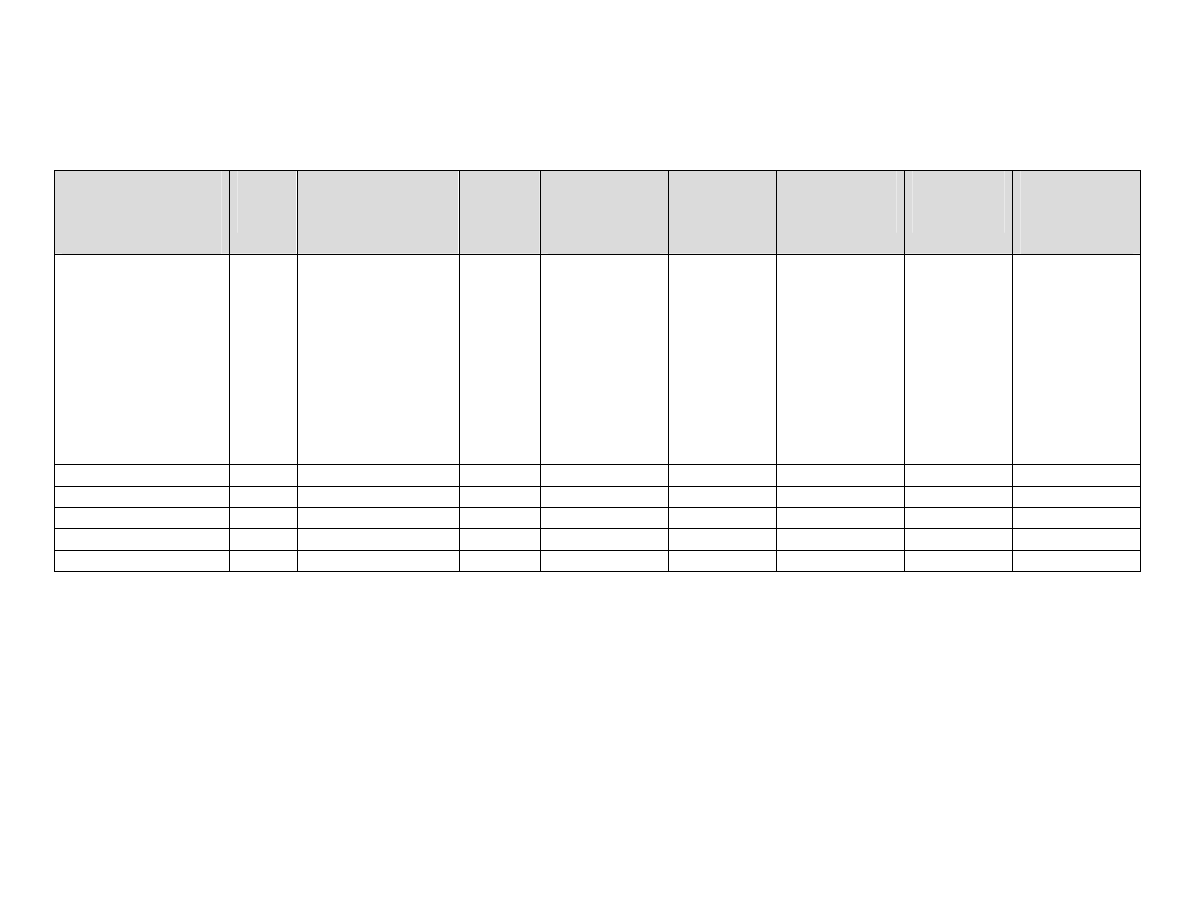
Special Publication 800-30
Risk Management Guide for
Information Technology Systems
Recommendations of the National Institute of
Standards and Technology
Gary Stoneburner, Alice Goguen, and Alexis Feringa

C O M P U T E R S E C U R I T Y
NIST Special Publication 800-30
Risk Management Guide for
Information Technology Systems
Recommendations of the
National Institute of Standards and Technology
Gary Stoneburner, Alice Goguen, and Alexis
Feringa
SP 800-30
Page ii
U.S. DEPARTMENT OF COMMERCE
Donald L. Evans, Secretary
TECHNOLOGY ADMINISTRATION
Phillip J. Bond, Under Secretary for Technology
NATIONAL INSTITUTE OF STANDARDS AND TECHNOLOGY
Arden L. Bement, Jr., Director

Reports on Computer Systems Technology
The Information Technology Laboratory (ITL) at the National Institute of Standards and Technology
promotes the U.S. economy and public welfare by providing technical leadership for the nation’s
measurement and standards infrastructure. ITL develops tests, test methods, reference data, proof-of-
concept implementations, and technical analyses to advance the development and productive use of
information technology. ITL’s responsibilities include the development of technical, physical,
administrative, and management standards and guidelines for the cost-effective security and privacy of
sensitive unclassified information in federal computer systems. The Special Publication 800-series reports
on ITL’s research, guidance, and outreach efforts in computer security, and its collaborative activities
with industry, government, and academic organizations.
National Institute of Standards and Technology Special Publication 800-30
Natl. Inst. Stand. Technol. Spec. Publ. 800-30, XX pages (October 2001)
CODEN: NSPUE2
Certain commercial entities, equipment, or materials may be identified in this document in order to describe an
experimental procedure or concept adequately. Such identification is not intended to imply recommendation or
endorsement by the National Institute of Standards and Technology, nor is it intended to imply that the entities,
materials, or equipment are necessarily the best available for the purpose.
U.S. GOVERNMENT PRINTING OFFICE
WASHINGTON: 2001
For sale by the Superintendent of Documents, U.S. Government Printing Office
Internet: bookstore.gpo.gov — Phone: (202) 512-1800 — Fax: (202) 512-2250
Mail: Stop SSOP, Washington, DC 20402-0001
SP 800-30
Page iii

Acknowledgements
The authors, Gary Stoneburner, from NIST and Alice Goguen and Alexis Feringa from Booz
Allen Hamilton wish to express their thanks to their colleagues at both organizations who
reviewed drafts of this document. In particular, Timothy Grance, Marianne Swanson, and Joan
Hash from NIST and Debra L. Banning, Jeffrey Confer, Randall K. Ewell, and Waseem
Mamlouk from Booz Allen provided valuable insights that contributed substantially to the
technical content of this document. Moreover, we gratefully acknowledge and appreciate the
many comments from the public and private sectors whose thoughtful and constructive
comments improved the quality and utility of this publication.
SP 800-30
Page iv

TABLE OF CONTENTS
SDLC.....................................................................................4
................................................................................................15
............................................................................................29
Appendix A—Sample Interview Questions ............................................................................................................. A-1
Appendix B—Sample Risk Assessment Report Outline ...........................................................................................B-1
SP 800-30
Page iv

Appendix C—Sample Implementation Safeguard Plan Summary Table ..................................................................C-1
Appendix D—Acronyms .......................................................................................................................................... D-1
Appendix E—Glossary..............................................................................................................................................E-1
Appendix F—References........................................................................................................................................... F-1
LIST OF FIGURES
Figure 3-1 Risk Assessment Methodology Flowchart...................................................................................................9
Figure 4-1 Risk Mitigation Action Points....................................................................................................................28
Figure 4-2 Risk Mitigation Methodology Flowchart...................................................................................................31
Figure 4-3 Technical Security Controls.......................................................................................................................33
Figure 4-4 Control Implementation and Residual Risk ...............................................................................................40
LIST OF TABLES
Table 2-1 Integration of Risk Management to the SDLC..............................................................................................5
Table 3-1 Human Threats: Threat-Source, Motivation, and Threat Actions ...............................................................14
Table 3-2 Vulnerability/Threat Pairs ...........................................................................................................................15
Table 3-3 Security Criteria ..........................................................................................................................................18
Table 3-4 Likelihood Definitions ................................................................................................................................21
Table 3-5 Magnitude of Impact Definitions ................................................................................................................23
Table 3-6 Risk-Level Matrix .......................................................................................................................................25
Table 3-7 Risk Scale and Necessary Actions ..............................................................................................................25
SP 800-30
Page v

1.
INTRODUCTION
Every organization has a mission. In this digital era, as organizations use automated information
technology (IT) systems
to process their information for better support of their missions, risk
management plays a critical role in protecting an organization’s information assets, and therefore
its mission, from IT-related risk.
An effective risk management process is an important component of a successful IT security
program. The principal goal of an organization’s risk management process should be to protect
the organization and its ability to perform their mission, not just its IT assets. Therefore, the risk
management process should not be treated primarily as a technical function carried out by the IT
experts who operate and manage the IT system, but as an essential management function of the
organization.
1.1 AUTHORITY
This document has been developed by NIST in furtherance of its statutory responsibilities under
the Computer Security Act of 1987 and the Information Technology Management Reform Act of
1996 (specifically 15 United States Code (U.S.C.) 278 g-3 (a)(5)). This is not a guideline within
the meaning of 15 U.S.C 278 g-3 (a)(3).
These guidelines are for use by Federal organizations which process sensitive information.
They are consistent with the requirements of OMB Circular A-130, Appendix III.
The guidelines herein are not mandatory and binding standards. This document may be used by
non-governmental organizations on a voluntary basis. It is not subject to copyright.
Nothing in this document should be taken to contradict standards and guidelines made
mandatory and binding upon Federal agencies by the Secretary of Commerce under his statutory
authority. Nor should these guidelines be interpreted as altering or superseding the existing
authorities of the Secretary of Commerce, the Director of the Office of Management and Budget,
or any other Federal official
.
1.2 PURPOSE
Risk is the net negative impact of the exercise of a vulnerability, considering both the probability
and the impact of occurrence. Risk management is the process of identifying risk, assessing risk,
and taking steps to reduce risk to an acceptable level. This guide provides a foundation for the
development of an effective risk management program, containing both the definitions and the
practical guidance necessary for assessing and mitigating risks identified within IT systems. The
ultimate goal is to help organizations to better manage IT-related mission risks.
1
The term “IT system” refers to a general support system (e.g., mainframe computer, mid-range computer, local
area network, agencywide backbone) or a major application that can run on a general support system and whose
use of information resources satisfies a specific set of user requirements.
SP 800-30
Page 1

In addition, this guide provides information on the selection of cost-effective security controls.
These controls can be used to mitigate risk for the better protection of mission-critical
information and the IT systems that process, store, and carry this information.
Organizations may choose to expand or abbreviate the comprehensive processes and steps
suggested in this guide and tailor them to their environment in managing IT-related mission
risks.
1.3 OBJECTIVE
The objective of performing risk management is to enable the organization to accomplish its
mission(s) (1) by better securing the IT systems that store, process, or transmit organizational
information; (2) by enabling management to make well-informed risk management decisions to
justify the expenditures that are part of an IT budget; and (3) by assisting management in
authorizing (or accrediting) the IT systems
on the basis of the supporting documentation
resulting from the performance of risk management.
1.4 TARGET
AUDIENCE
This guide provides a common foundation for experienced and inexperienced, technical, and
non-technical personnel who support or use the risk management process for their IT systems.
These personnel include
•
•
•
•
•
•
•
•
•
•
Senior management, the mission owners, who make decisions about the IT security
budget.
Federal Chief Information Officers, who ensure the implementation of risk
management for agency IT systems and the security provided for these IT systems
The Designated Approving Authority (DAA), who is responsible for the final
decision on whether to allow operation of an IT system
The IT security program manager, who implements the security program
Information system security officers (ISSO), who are responsible for IT security
IT system owners of system software and/or hardware used to support IT functions.
Information owners of data stored, processed, and transmitted by the IT systems
Business or functional managers, who are responsible for the IT procurement process
Technical support personnel (e.g., network, system, application, and database
administrators; computer specialists; data security analysts), who manage and
administer security for the IT systems
IT system and application programmers, who develop and maintain code that could
affect system and data integrity
2
The terms “safeguards” and “controls” refer to risk-reducing measures; these terms are used interchangeably in
this guidance document.
3
Office of Management and Budget’s November 2000 Circular A-130, the Computer Security Act of 1987, and the
Government Information Security Reform Act of October 2000 require that an IT system be authorized prior to
operation and reauthorized at least every 3 years thereafter.
SP 800-30
Page 2

IT quality assurance personnel, who test and ensure the integrity of the IT systems
and data
•
•
•
•
•
•
•
Information system auditors, who audit IT systems
IT consultants, who support clients in risk management.
1.5 RELATED
REFERENCES
This guide is based on the general concepts presented in National Institute of Standards and
Technology (NIST) Special Publication (SP) 800-27, Engineering Principles for IT Security,
along with the principles and practices in NIST SP 800-14, Generally Accepted Principles and
Practices for Securing Information Technology Systems. In addition, it is consistent with the
policies presented in Office of Management and Budget (OMB) Circular A-130, Appendix III,
“Security of Federal Automated Information Resources”; the Computer Security Act (CSA) of
1987; and the Government Information Security Reform Act of October 2000.
1.6 GUIDE
STRUCTURE
The remaining sections of this guide discuss the following:
Section 2 provides an overview of risk management, how it fits into the system
development life cycle (SDLC), and the roles of individuals who support and use this
process.
Section 3 describes the risk assessment methodology and the nine primary steps in
conducting a risk assessment of an IT system.
Section 4 describes the risk mitigation process, including risk mitigation options and
strategy, approach for control implementation, control categories, cost-benefit
analysis, and residual risk.
Section 5 discusses the good practice and need for an ongoing risk evaluation and
assessment and the factors that will lead to a successful risk management program.
This guide also contains six appendixes. Appendix A provides sample interview questions.
Appendix B provides a sample outline for use in documenting risk assessment results. Appendix
C contains a sample table for the safeguard implementation plan. Appendix D provides a list of
the acronyms used in this document. Appendix E contains a glossary of terms used frequently in
this guide. Appendix F lists references.
SP 800-30
Page 3

2.
RISK MANAGEMENT OVERVIEW
This guide describes the risk management methodology, how it fits into each phase of the SDLC,
and how the risk management process is tied to the process of system authorization (or
accreditation).
2.1 IMPORTANCE OF RISK MANAGEMENT
Risk management encompasses three processes: risk assessment, risk mitigation, and evaluation
and assessment. Section 3 of this guide describes the risk assessment process, which includes
identification and evaluation of risks and risk impacts, and recommendation of risk-reducing
measures. Section 4 describes risk mitigation, which refers to prioritizing, implementing, and
maintaining the appropriate risk-reducing measures recommended from the risk assessment
process. Section 5 discusses the continual evaluation process and keys for implementing a
successful risk management program. The DAA or system authorizing official is responsible for
determining whether the remaining risk is at an acceptable level or whether additional security
controls should be implemented to further reduce or eliminate the residual risk before
authorizing (or accrediting) the IT system for operation.
Risk management is the process that allows IT managers to balance the operational and
economic costs of protective measures and achieve gains in mission capability by protecting the
IT systems and data that support their organizations’ missions. This process is not unique to the
IT environment; indeed it pervades decision-making in all areas of our daily lives. Take the case
of home security, for example. Many people decide to have home security systems installed and
pay a monthly fee to a service provider to have these systems monitored for the better protection
of their property. Presumably, the homeowners have weighed the cost of system installation and
monitoring against the value of their household goods and their family’s safety, a fundamental
“mission” need.
The head of an organizational unit must ensure that the organization has the capabilities needed
to accomplish its mission. These mission owners must determine the security capabilities that
their IT systems must have to provide the desired level of mission support in the face of real-
world threats. Most organizations have tight budgets for IT security; therefore, IT security
spending must be reviewed as thoroughly as other management decisions. A well-structured risk
management methodology, when used effectively, can help management identify appropriate
controls for providing the mission-essential security capabilities.
2.2 INTEGRATION OF RISK MANAGEMENT INTO SDLC
Minimizing negative impact on an organization and need for sound basis in decision making are
the fundamental reasons organizations implement a risk management process for their IT
systems. Effective risk management must be totally integrated into the SDLC. An IT system’s
SDLC has five phases: initiation, development or acquisition, implementation, operation or
maintenance, and disposal. In some cases, an IT system may occupy several of these phases at
the same time. However, the risk management methodology is the same regardless of the SDLC
phase for which the assessment is being conducted. Risk management is an iterative process that
can be performed during each major phase of the SDLC. Table 2-1 describes the characteristics
SP 800-30
Page 4

of each SDLC phase and indicates how risk management can be performed in support of each
phase.
Table 2-1 Integration of Risk Management into the SDLC
SDLC Phases
Phase Characteristics
Support from Risk
Management Activities
Phase 1—Initiation
The need for an IT system is
expressed and the purpose and
scope of the IT system is
documented
•
Identified risks are used to
support the development of the
system requirements, including
security requirements, and a
security concept of operations
(strategy)
Phase 2—Development or
Acquisition
The IT system is designed,
purchased, programmed,
developed, or otherwise
constructed
•
The risks identified during this
phase can be used to support
the security analyses of the IT
system that may lead to
architecture and design trade-
offs during system
development
Phase 3—Implementation
The system security features
should be configured, enabled,
tested, and verified
•
The risk management process
supports the assessment of the
system implementation against
its requirements and within its
modeled operational
environment. Decisions
regarding risks identified must
be made prior to system
operation
Phase 4—Operation or
Maintenance
The system performs its
functions. Typically the system is
being modified on an ongoing
basis through the addition of
hardware and software and by
changes to organizational
processes, policies, and
procedures
•
Risk management activities are
performed for periodic system
reauthorization (or
reaccreditation) or whenever
major changes are made to an
IT system in its operational,
production environment (e.g.,
new system interfaces)
Phase 5—Disposal
This phase may involve the
disposition of information,
hardware, and software.
Activities may include moving,
archiving, discarding, or
destroying information and
sanitizing the hardware and
software
•
Risk management activities
are performed for system
components that will be
disposed of or replaced to
ensure that the hardware and
software are properly disposed
of, that residual data is
appropriately handled, and that
system migration is conducted
in a secure and systematic
manner
SP 800-30
Page 5

2.3 KEY
ROLES
Risk management is a management responsibility. This section describes the key roles of the
personnel who should support and participate in the risk management process.
Senior Management. Senior management, under the standard of due care and
ultimate responsibility for mission accomplishment, must ensure that the necessary
resources are effectively applied to develop the capabilities needed to accomplish the
mission. They must also assess and incorporate results of the risk assessment activity
into the decision making process. An effective risk management program that
assesses and mitigates IT-related mission risks requires the support and involvement
of senior management.
•
•
•
•
•
•
Chief Information Officer (CIO). The CIO is responsible for the agency’s IT
planning, budgeting, and performance including its information security components.
Decisions made in these areas should be based on an effective risk management
program.
System and Information Owners. The system and information owners are
responsible for ensuring that proper controls are in place to address integrity,
confidentiality, and availability of the IT systems and data they own. Typically the
system and information owners are responsible for changes to their IT systems. Thus,
they usually have to approve and sign off on changes to their IT systems (e.g., system
enhancement, major changes to the software and hardware). The system and
information owners must therefore understand their role in the risk management
process and fully support this process.
Business and Functional Managers. The managers responsible for business
operations and IT procurement process must take an active role in the risk
management process. These managers are the individuals with the authority and
responsibility for making the trade-off decisions essential to mission accomplishment.
Their involvement in the risk management process enables the achievement of proper
security for the IT systems, which, if managed properly, will provide mission
effectiveness with a minimal expenditure of resources.
ISSO. IT security program managers and computer security officers are responsible
for their organizations’ security programs, including risk management. Therefore,
they play a leading role in introducing an appropriate, structured methodology to help
identify, evaluate, and minimize risks to the IT systems that support their
organizations’ missions. ISSOs also act as major consultants in support of senior
management to ensure that this activity takes place on an ongoing basis.
IT Security Practitioners. IT security practitioners (e.g., network, system,
application, and database administrators; computer specialists; security analysts;
security consultants) are responsible for proper implementation of security
requirements in their IT systems. As changes occur in the existing IT system
environment (e.g., expansion in network connectivity, changes to the existing
infrastructure and organizational policies, introduction of new technologies), the IT
security practitioners must support or use the risk management process to identify and
assess new potential risks and implement new security controls as needed to
safeguard their IT systems.
SP 800-30
Page 6

Security Awareness Trainers (Security/Subject Matter Professionals). The
organization’s personnel are the users of the IT systems. Use of the IT systems and
data according to an organization’s policies, guidelines, and rules of behavior is
critical to mitigating risk and protecting the organization’s IT resources. To minimize
risk to the IT systems, it is essential that system and application users be provided
with security awareness training. Therefore, the IT security trainers or
security/subject matter professionals must understand the risk management process so
that they can develop appropriate training materials and incorporate risk assessment
into training programs to educate the end users.
•
SP 800-30
Page 7

3.
RISK ASSESSMENT
Risk assessment is the first process in the risk management methodology. Organizations use risk
assessment to determine the extent of the potential threat and the risk associated with an IT
system throughout its SDLC. The output of this process helps to identify appropriate controls for
reducing or eliminating risk during the risk mitigation process, as discussed in Section 4.
Risk is a function of the likelihood of a given threat-source’s exercising a particular potential
vulnerability, and the resulting impact of that adverse event on the organization.
To determine the likelihood of a future adverse event, threats to an IT system must be analyzed
in conjunction with the potential vulnerabilities and the controls in place for the IT system.
Impact refers to the magnitude of harm that could be caused by a threat’s exercise of a
vulnerability. The level of impact is governed by the potential mission impacts and in turn
produces a relative value for the IT assets and resources affected (e.g., the criticality and
sensitivity of the IT system components and data). The risk assessment methodology
encompasses nine primary steps, which are described in Sections 3.1 through 3.9
Step 1
System Characterization (Section 3.1)
•
•
•
•
•
•
•
•
•
Step 2
Threat Identification (Section 3.2)
Step 3
Vulnerability Identification (Section 3.3)
Step 4
Control Analysis (Section 3.4)
Step 5
Likelihood Determination (Section 3.5)
Step 6
Impact Analysis (Section 3.6)
Step 7
Risk Determination (Section 3.7)
Step 8
Control Recommendations (Section 3.8)
Step 9
Results Documentation (Section 3.9).
Steps 2, 3, 4, and 6 can be conducted in parallel after Step 1 has been completed. Figure 3-1
depicts these steps and the inputs to and outputs from each step.
SP 800-30
Page 8

List of Current and
Planned Controls
Step 4. Control Analysis
Threat Statement
Step 2.
Threat Identification
List of Potential
Vulnerabilities
Step 3.
Vulnerability Identification
• Reports from prior risk
assessments
• Any audit comments
• Security requirements
• Security test results
• Hardware
• Software
• System interfaces
• Data and information
• People
• System mission
Step 1.
System Characterization
Likelihood Rating
Step 5.
Likelihood Determination
•
Threat-source motivation
• Threat capacity
• Nature of vulnerability
• Current controls
Step 9.
Results Documentation
Risk Assessment
Report
Step 6. Impact Analysis
•
Loss of Integrity
• Loss of Availability
• Loss of Confidentiality
Impact Rating
•
Mission impact analysis
• Asset criticality assessment
• Data criticality
• Data sensitivity
Risks and
Associated Risk
Levels
Step 7. Risk Determination
• Likelihood of threat
exploitation
• Magnitude of impact
• Adequacy of planned or
current controls
Recommended
Controls
Step 8.
Control Recommendations
Input
Risk Assessment Activities
Output
• System Boundary
• System Functions
• System and Data
Criticality
• System and Data
Sensitivity
• Current controls
• Planned controls
• History of system attack
• Data from intelligence
agencies, NIPC, OIG,
FedCIRC, mass media,
List of Current and
Planned Controls
List of Current and
Planned Controls
Step 4. Control Analysis
Threat Statement
Step 2.
Threat Identification
List of Potential
Vulnerabilities
Step 3.
Vulnerability Identification
• Reports from prior risk
assessments
• Any audit comments
• Security requirements
• Security test results
• Reports from prior risk
assessments
• Any audit comments
• Security requirements
• Security test results
• Hardware
• Software
• System interfaces
• Data and information
• People
• System mission
Step 1.
System Characterization
Likelihood Rating
Step 5.
Likelihood Determination
•
Threat-source motivation
• Threat capacity
• Nature of vulnerability
• Current controls
Step 9.
Results Documentation
Risk Assessment
Report
Step 6. Impact Analysis
•
Loss of Integrity
• Loss of Availability
• Loss of Confidentiality
Impact Rating
•
Mission impact analysis
• Asset criticality assessment
• Data criticality
• Data sensitivity
Risks and
Associated Risk
Levels
Step 7. Risk Determination
• Likelihood of threat
exploitation
• Magnitude of impact
• Adequacy of planned or
current controls
Recommended
Controls
Step 8.
Control Recommendations
Input
Risk Assessment Activities
Output
• System Boundary
• System Functions
• System and Data
Criticality
• System and Data
Sensitivity
• Current controls
• Planned controls
• Current controls
• Planned controls
• History of system attack
• Data from intelligence
agencies, NIPC, OIG,
FedCIRC, mass media,
Figure 3-1. Risk Assessment Methodology Flowchart
SP 800-30
Page 9

3.1 STEP 1: SYSTEM CHARACTERIZATION
In assessing risks for an IT system, the first step is to define the scope of the effort. In this step,
the boundaries of the IT system are identified, along with the resources and the information that
constitute the system. Characterizing an IT system establishes the scope of the risk assessment
effort, delineates the operational authorization (or accreditation) boundaries, and provides
information (e.g., hardware, software, system connectivity, and responsible division or support
personnel) essential to defining the risk.
Section 3.1.1 describes the system-related information used to characterize an IT system and its
operational environment. Section 3.1.2 suggests the information-gathering techniques that can
be used to solicit information relevant to the IT system processing environment.
The methodology described in this document can be applied to assessments of single or multiple,
interrelated systems. In the latter case, it is important that the domain of interest and all interfaces
and dependencies be well defined prior to applying the methodology.
3.1.1 System-Related Information
Identifying risk for an IT system requires a keen understanding of the system’s processing
environment. The person or persons who conduct the risk assessment must therefore first collect
system-related information, which is usually classified as follows:
•
•
•
•
•
•
•
•
•
•
•
•
Hardware
Software
System interfaces (e.g., internal and external connectivity)
Data and information
Persons who support and use the IT system
System mission (e.g., the processes performed by the IT system)
System and data criticality (e.g., the system’s value or importance to an organization)
System and data sensitivity.
Additional information related to the operational environmental of the IT system and its data
includes, but is not limited to, the following:
The functional requirements of the IT system
Users of the system (e.g., system users who provide technical support to the IT
system; application users who use the IT system to perform business functions)
System security policies governing the IT system (organizational policies, federal
requirements, laws, industry practices)
System security architecture
4
The level of protection required to maintain system and data integrity, confidentiality, and availability.
SP 800-30
Page 10

Current network topology (e.g., network diagram)
•
•
•
•
•
•
•
•
•
•
Information storage protection that safeguards system and data availability, integrity,
and confidentiality
Flow of information pertaining to the IT system (e.g., system interfaces, system input
and output flowchart)
Technical controls used for the IT system (e.g., built-in or add-on security product
that supports identification and authentication, discretionary or mandatory access
control, audit, residual information protection, encryption methods)
Management controls used for the IT system (e.g., rules of behavior, security
planning)
Operational controls used for the IT system (e.g., personnel security, backup,
contingency, and resumption and recovery operations; system maintenance; off-site
storage; user account establishment and deletion procedures; controls for segregation
of user functions, such as privileged user access versus standard user access)
Physical security environment of the IT system (e.g., facility security, data center
policies)
Environmental security implemented for the IT system processing environment (e.g.,
controls for humidity, water, power, pollution, temperature, and chemicals).
For a system that is in the initiation or design phase, system information can be derived from the
design or requirements document. For an IT system under development, it is necessary to define
key security rules and attributes planned for the future IT system. System design documents and
the system security plan can provide useful information about the security of an IT system that is
in development.
For an operational IT system, data is collected about the IT system in its production
environment, including data on system configuration, connectivity, and documented and
undocumented procedures and practices. Therefore, the system description can be based on the
security provided by the underlying infrastructure or on future security plans for the IT system.
3.1.2 Information-Gathering
Techniques
Any, or a combination, of the following techniques can be used in gathering information relevant
to the IT system within its operational boundary:
Questionnaire. To collect relevant information, risk assessment personnel can
develop a questionnaire concerning the management and operational controls planned
or used for the IT system. This questionnaire should be distributed to the applicable
technical and nontechnical management personnel who are designing or supporting
the IT system. The questionnaire could also be used during on-site visits and
interviews.
On-site Interviews. Interviews with IT system support and management personnel
can enable risk assessment personnel to collect useful information about the IT
system (e.g., how the system is operated and managed). On-site visits also allow risk
SP 800-30
Page 11

assessment personnel to observe and gather information about the physical,
environmental, and operational security of the IT system. Appendix A contains
sample interview questions asked during interviews with site personnel to achieve a
better understanding of the operational characteristics of an organization. For
systems still in the design phase, on-site visit would be face-to-face data gathering
exercises and could provide the opportunity to evaluate the physical environment in
which the IT system will operate.
•
•
Document Review. Policy documents (e.g., legislative documentation, directives),
system documentation (e.g., system user guide, system administrative manual,
system design and requirement document, acquisition document), and security-related
documentation (e.g., previous audit report, risk assessment report, system test results,
system security plan
, security policies) can provide good information about the
security controls used by and planned for the IT system. An organization’s mission
impact analysis or asset criticality assessment provides information regarding system
and data criticality and sensitivity.
Use of Automated Scanning Tool. Proactive technical methods can be used to
collect system information efficiently. For example, a network mapping tool can
identify the services that run on a large group of hosts and provide a quick way of
building individual profiles of the target IT system(s).
Information gathering can be conducted throughout the risk assessment process, from Step 1
(System Characterization) through Step 9 (Results Documentation).
Output from Step 1
Characterization of the IT system assessed, a good picture of the IT
system environment, and delineation of system boundary
3.2 STEP 2: THREAT IDENTIFICATION
Threat: The potential for a threat-
source to exercise (accidentally trigger
or intentionally exploit) a specific
vulnerability.
A threat is the potential for a particular threat-source to successfully exercise a particular
vulnerability. A vulnerability is a weakness that can
be accidentally triggered or intentionally exploited. A
threat-source does not present a risk when there is no
vulnerability that can be exercised. In determining the
likelihood of a threat (Section 3.5), one must consider
threat-sources, potential vulnerabilities (Section 3.3),
and existing controls (Section 3.4).
3.2.1 Threat-Source
Identification
The goal of this step is to identify the potential
threat-sources and compile a threat statement
listing potential threat-sources that are applicable
to the IT system being evaluated.
Threat-Source: Either (1) intent and method
targeted at the intentional exploitation of a
vulnerability or (2) a situation and method
that may accidentally trigger a vulnerability.
5
During the initial phase, a risk assessment could be used to develop the initial system security plan.
SP 800-30
Page 12

A threat-source is defined as any
circumstance or event with the
potential to cause harm to an IT
system. The common threat-
sources can be natural, human, or
environmental.
Common Threat-Sources
!
Natural Threats—Floods, earthquakes, tornadoes,
landslides, avalanches, electrical storms, and other such
events.
!
Human Threats—Events that are either enabled by or
caused by human beings, such as unintentional acts
(inadvertent data entry) or deliberate actions (network
based attacks, malicious software upload, unauthorized
access to confidential information).
!
Environmental Threats—Long-term power failure,
pollution, chemicals, liquid leakage.
In assessing threat-sources, it is
important to consider all potential
threat-sources that could cause
harm to an IT system and its
processing environment. For
example, although the threat
statement for an IT system
located in a desert may not
include “natural flood” because
of the low likelihood of such an event’s occurring, environmental threats such as a bursting pipe
can quickly flood a computer room and cause damage to an organization’s IT assets and
resources. Humans can be threat-sources through intentional acts, such as deliberate attacks by
malicious persons or disgruntled employees, or unintentional acts, such as negligence and errors.
A deliberate attack can be either (1) a malicious attempt to gain unauthorized access to an IT
system (e.g., via password guessing) in order to compromise system and data integrity,
availability, or confidentiality or (2) a benign, but nonetheless purposeful, attempt to circumvent
system security. One example of the latter type of deliberate attack is a programmer’s writing a
Trojan horse program to bypass system security in order to “get the job done.”
3.2.2 Motivation and Threat Actions
Motivation and the resources for carrying out an attack make humans potentially dangerous
threat-sources. Table 3-1 presents an overview of many of today’s common human threats, their
possible motivations, and the methods or threat actions by which they might carry out an attack.
This information will be useful to organizations studying their human threat environments and
customizing their human threat statements. In addition, reviews of the history of system break-
ins; security violation reports; incident reports; and interviews with the system administrators,
help desk personnel, and user community during information gathering will help identify human
threat-sources that have the potential to harm an IT system and its data and that may be a concern
where a vulnerability exists.
SP 800-30
Page 13

Table 3-1. Human Threats: Threat-Source, Motivation, and Threat Actions
Threat-Source
Motivation
Threat Actions
Hacker, cracker
Challenge
Ego
Rebellion
•
Hacking
•
Social engineering
•
System intrusion, break-ins
•
Unauthorized system access
Computer criminal
Destruction of information
Illegal information disclosure
Monetary gain
Unauthorized data alteration
•
Computer crime (e.g., cyber
stalking)
•
Fraudulent act (e.g., replay,
impersonation, interception)
•
Information bribery
•
Spoofing
•
System intrusion
Terrorist
Blackmail
Destruction
Exploitation
Revenge
•
Bomb/Terrorism
•
Information warfare
•
System attack (e.g., distributed
denial of service)
•
System penetration
•
System tampering
Industrial espionage
(companies, foreign
governments, other
government interests)
Competitive advantage
Economic espionage
•
Economic exploitation
•
Information theft
•
Intrusion on personal privacy
•
Social engineering
•
System penetration
•
Unauthorized system access
(access to classified, proprietary,
and/or technology-related
information)
Insiders (poorly trained,
disgruntled, malicious,
negligent, dishonest, or
terminated employees)
Curiosity
Ego
Intelligence
Monetary gain
Revenge
Unintentional errors and
omissions (e.g., data entry
error, programming error)
•
Assault on an employee
•
Blackmail
•
Browsing of proprietary
information
•
Computer abuse
•
Fraud and theft
•
Information bribery
•
Input of falsified, corrupted data
•
Interception
•
Malicious code (e.g., virus, logic
bomb, Trojan horse)
•
Sale of personal information
•
System bugs
•
System intrusion
•
System sabotage
•
Unauthorized system access
An estimate of the motivation, resources, and capabilities that may be required to carry out a
successful attack should be developed after the potential threat-sources have been identified, in
order to determine the likelihood of a threat’s exercising a system vulnerability, as described in
Section 3.5.
SP 800-30
Page 14

The threat statement, or the list of potential threat-sources, should be tailored to the individual
organization and its processing environment (e.g., end-user computing habits). In general,
information on natural threats (e.g., floods, earthquakes, storms) should be readily available.
Known threats have been identified by many government and private sector organizations.
Intrusion detection tools also are becoming more prevalent, and government and industry
organizations continually collect data on security events, thereby improving the ability to
realistically assess threats. Sources of information include, but are not limited to, the following:
Intelligence agencies (for example, the Federal Bureau of Investigation’s National
Infrastructure Protection Center)
•
•
•
Federal Computer Incident Response Center (FedCIRC)
Mass media, particularly Web-based resources such as SecurityFocus.com,
SecurityWatch.com, SecurityPortal.com, and SANS.org.
Output from Step 2
A threat statement containing a list of threat-sources that could exploit
system vulnerabilities
3.3 STEP 3: VULNERABILITY IDENTIFICATION
The analysis of the threat to an IT system
must include an analysis of the
vulnerabilities associated with the system
environment. The goal of this step is to
develop a list of system vulnerabilities
(flaws or weaknesses) that could be
exploited by the potential threat-sources.
Vulnerability: A flaw or weakness in system
security procedures, design, implementation, or
internal controls that could be exercised
(accidentally triggered or intentionally exploited)
and result in a security breach or a violation of the
system’s security policy.
Table 3-2 presents examples of vulnerability/threat pairs.
Table 3-2. Vulnerability/Threat Pairs
Vulnerability
Threat-Source
Threat Action
Terminated employees’ system
identifiers (ID) are not removed
from the system
Terminated employees
Dialing into the company’s
network and accessing
company proprietary data
Company firewall allows inbound
telnet, and guest ID is enabled on
XYZ server
Unauthorized users (e.g.,
hackers, terminated
employees, computer
criminals, terrorists)
Using telnet to XYZ server
and browsing system files
with the guest ID
The vendor has identified flaws in
the security design of the system;
however, new patches have not
been applied to the system
Unauthorized users (e.g.,
hackers, disgruntled
employees, computer
criminals, terrorists)
Obtaining unauthorized
access to sensitive system
files based on known
system vulnerabilities
SP 800-30
Page 15

Vulnerability
Threat-Source
Threat Action
Data center uses water sprinklers
to suppress fire; tarpaulins to
protect hardware and equipment
from water damage are not in
place
Fire, negligent persons
Water sprinklers being
turned on in the data center
Recommended methods for identifying system vulnerabilities are the use of vulnerability
sources, the performance of system security testing, and the development of a security
requirements checklist.
It should be noted that the types of vulnerabilities that will exist, and the methodology needed to
determine whether the vulnerabilities are present, will usually vary depending on the nature of
the IT system and the phase it is in, in the SDLC:
If the IT system has not yet been designed, the search for vulnerabilities should focus
on the organization’s security policies, planned security procedures, and system
requirement definitions, and the vendors’ or developers’ security product analyses
(e.g., white papers).
•
•
•
•
•
•
If the IT system is being implemented, the identification of vulnerabilities should be
expanded to include more specific information, such as the planned security features
described in the security design documentation and the results of system certification
test and evaluation.
If the IT system is operational, the process of identifying vulnerabilities should
include an analysis of the IT system security features and the security controls,
technical and procedural, used to protect the system.
3.3.1 Vulnerability
Sources
The technical and nontechnical vulnerabilities associated with an IT system’s processing
environment can be identified via the information-gathering techniques described in Section
3.1.2. A review of other industry sources (e.g., vendor Web pages that identify system bugs and
flaws) will be useful in preparing for the interviews and in developing effective questionnaires to
identify vulnerabilities that may be applicable to specific IT systems (e.g., a specific version of a
specific operating system). The Internet is another source of information on known system
vulnerabilities posted by vendors, along with hot fixes, service packs, patches, and other
remedial measures that may be applied to eliminate or mitigate vulnerabilities. Documented
vulnerability sources that should be considered in a thorough vulnerability analysis include, but
are not limited to, the following:
Previous risk assessment documentation of the IT system assessed
The IT system’s audit reports, system anomaly reports, security review reports, and
system test and evaluation reports
Vulnerability lists, such as the NIST I-CAT vulnerability database
(http://icat.nist.gov)
SP 800-30
Page 16

•
•
•
•
•
•
•
•
Security advisories, such as FedCIRC and the Department of Energy’s Computer
Incident Advisory Capability bulletins
Vendor advisories
Commercial computer incident/emergency response teams and post lists (e.g.,
SecurityFocus.com forum mailings)
Information Assurance Vulnerability Alerts and bulletins for military systems
System software security analyses.
3.3.2 System Security Testing
Proactive methods, employing system testing, can be used to identify system vulnerabilities
efficiently, depending on the criticality of the IT system and available resources (e.g., allocated
funds, available technology, persons with the expertise to conduct the test). Test methods
include
Automated vulnerability scanning tool
Security test and evaluation (ST&E)
Penetration testing.
The automated vulnerability scanning tool is used to scan a group of hosts or a network for
known vulnerable services (e.g., system allows anonymous File Transfer Protocol [FTP],
sendmail relaying). However, it should be noted that some of the potential vulnerabilities
identified by the automated scanning tool may not represent real vulnerabilities in the context of
the system environment. For example, some of these scanning tools rate potential vulnerabilities
without considering the site’s environment and requirements. Some of the “vulnerabilities”
flagged by the automated scanning software may actually not be vulnerable for a particular site
but may be configured that way because their environment requires it. Thus, this test method
may produce false positives.
ST&E is another technique that can be used in identifying IT system vulnerabilities during the
risk assessment process. It includes the development and execution of a test plan (e.g., test
script, test procedures, and expected test results). The purpose of system security testing is to
test the effectiveness of the security controls of an IT system as they have been applied in an
operational environment. The objective is to ensure that the applied controls meet the approved
security specification for the software and hardware and implement the organization’s security
policy or meet industry standards.
Penetration testing can be used to complement the review of security controls and ensure that
different facets of the IT system are secured. Penetration testing, when employed in the risk
assessment process, can be used to assess an IT system’s ability to withstand intentional attempts
to circumvent system security. Its objective is to test the IT system from the viewpoint of a
threat-source and to identify potential failures in the IT system protection schemes.
6
The NIST SP draft 800-42, Network Security Testing Overview, describes the methodology for network system
testing and the use of automated tools.
SP 800-30
Page 17

The results of these types of optional security testing will help identify a system’s vulnerabilities.
3.3.3 Development of Security Requirements Checklist
During this step, the risk assessment personnel determine whether the security requirements
stipulated for the IT system and collected during system characterization are being met by
existing or planned security controls. Typically, the system security requirements can be
presented in table form, with each requirement accompanied by an explanation of how the
system’s design or implementation does or does not satisfy that security control requirement.
A security requirements checklist contains the basic security standards that can be used to
systematically evaluate and identify the vulnerabilities of the assets (personnel, hardware,
software, information), nonautomated procedures, processes, and information transfers
associated with a given IT system in the following security areas:
Management
•
•
•
Operational
Technical.
Table 3-3 lists security criteria suggested for use in identifying an IT system’s vulnerabilities in
each security area.
Table 3-3. Security Criteria
Security Area
Security Criteria
Management Security
•
Assignment of responsibilities
•
Continuity of support
•
Incident response capability
•
Periodic review of security controls
•
Personnel clearance and background investigations
•
Risk assessment
•
Security and technical training
•
Separation of duties
•
System authorization and reauthorization
•
System or application security plan
Operational Security
•
Control of air-borne contaminants (smoke, dust, chemicals)
•
Controls to ensure the quality of the electrical power supply
•
Data media access and disposal
•
External data distribution and labeling
•
Facility protection (e.g., computer room, data center, office)
•
Humidity control
•
Temperature control
•
Workstations, laptops, and stand-alone personal computers
SP 800-30
Page 18

Security Area
Security Criteria
Technical Security
•
Communications (e.g., dial-in, system interconnection, routers)
•
Cryptography
•
Discretionary access control
•
Identification and authentication
•
Intrusion detection
•
Object reuse
•
System audit
The outcome of this process is the security requirements checklist. Sources that can be used in
compiling such a checklist include, but are not limited to, the following government regulatory
and security directives and sources applicable to the IT system processing environment:
•
•
•
•
•
•
•
CSA of 1987
Federal Information Processing Standards Publications
OMB November 2000 Circular A-130
Privacy Act of 1974
System security plan of the IT system assessed
The organization’s security policies, guidelines, and standards
Industry practices.
The NIST SP 800-26, Security Self-Assessment Guide for Information Technology Systems,
provides an extensive questionnaire containing specific control objectives against which a
system or group of interconnected systems can be tested and measured. The control objectives
are abstracted directly from long-standing requirements found in statute, policy, and guidance on
security and privacy.
The results of the checklist (or questionnaire) can be used as input for an evaluation of
compliance and noncompliance. This process identifies system, process, and procedural
weaknesses that represent potential vulnerabilities.
Output from Step 3
A list of the system vulnerabilities (observations)
by the potential threat-sources
3.4 STEP 4: CONTROL ANALYSIS
The goal of this step is to analyze the controls that have been implemented, or are planned for
implementation, by the organization to minimize or eliminate the likelihood (or probability) of a
threat’s exercising a system vulnerability.
7
Because the risk assessment report is not an audit report, some sites may prefer to address the identified
vulnerabilities as observations instead of findings in the risk assessment report.
SP 800-30
Page 19

To derive an overall likelihood rating that indicates the probability that a potential vulnerability
may be exercised within the construct of the associated threat environment (Step 5 below), the
implementation of current or planned controls must be considered. For example, a vulnerability
(e.g., system or procedural weakness) is not likely to be exercised or the likelihood is low if there
is a low level of threat-source interest or capability or if there are effective security controls that
can eliminate, or reduce the magnitude of, harm.
Sections 3.4.1 through 3.4.3, respectively, discuss control methods, control categories, and the
control analysis technique.
3.4.1 Control
Methods
Security controls encompass the use of technical and nontechnical methods. Technical controls
are safeguards that are incorporated into computer hardware, software, or firmware (e.g., access
control mechanisms, identification and authentication mechanisms, encryption methods,
intrusion detection software). Nontechnical controls are management and operational controls,
such as security policies; operational procedures; and personnel, physical, and environmental
security.
3.4.2 Control
Categories
The control categories for both technical and nontechnical control methods can be further
classified as either preventive or detective. These two subcategories are explained as follows:
Preventive controls inhibit attempts to violate security policy and include such
controls as access control enforcement, encryption, and authentication.
•
• Detective controls warn of violations or attempted violations of security policy and
include such controls as audit trails, intrusion detection methods, and checksums.
Section 4.4 further explains these controls from the implementation standpoint. The
implementation of such controls during the risk mitigation process is the direct result of the
identification of deficiencies in current or planned controls during the risk assessment process
(e.g., controls are not in place or controls are not properly implemented).
3.4.3 Control Analysis Technique
As discussed in Section 3.3.3, development of a security requirements checklist or use of an
available checklist will be helpful in analyzing controls in an efficient and systematic manner.
The security requirements checklist can be used to validate security noncompliance as well as
compliance. Therefore, it is essential to update such checklists to reflect changes in an
organization’s control environment (e.g., changes in security policies, methods, and
requirements) to ensure the checklist’s validity.
Output from Step 4
List of current or planned controls used for the IT system to mitigate the
likelihood of a vulnerability’s being exercised and reduce the impact of such an adverse event
SP 800-30
Page 20

3.5 STEP 5: LIKELIHOOD DETERMINATION
To derive an overall likelihood rating that indicates the probability that a potential vulnerability
may be exercised within the construct of the associated threat environment, the following
governing factors must be considered:
Threat-source motivation and capability
•
•
•
Nature of the vulnerability
Existence and effectiveness of current controls.
The likelihood that a potential vulnerability could be exercised by a given threat-source can be
described as high, medium, or low. Table 3-4 below describes these three likelihood levels.
Table 3-4. Likelihood Definitions
Likelihood Level
Likelihood Definition
High
The threat-source is highly motivated and sufficiently capable, and controls to
prevent the vulnerability from being exercised are ineffective.
Medium
The threat-source is motivated and capable, but controls are in place that may
impede successful exercise of the vulnerability.
Low
The threat-source lacks motivation or capability, or controls are in place to
prevent, or at least significantly impede, the vulnerability from being exercised.
Output from Step 5
Likelihood rating (High, Medium, Low)
3.6 STEP 6: IMPACT ANALYSIS
The next major step in measuring level of risk is to determine the adverse impact resulting from
a successful threat exercise of a vulnerability. Before beginning the impact analysis, it is
necessary to obtain the following necessary information as discussed in Section 3.1.1:
System mission (e.g., the processes performed by the IT system)
•
•
•
System and data criticality (e.g., the system’s value or importance to an organization)
System and data sensitivity.
This information can be obtained from existing organizational documentation, such as the
mission impact analysis report or asset criticality assessment report. A mission impact analysis
(also known as business impact analysis [BIA] for some organizations) prioritizes the impact
levels associated with the compromise of an organization’s information assets based on a
qualitative or quantitative assessment of the sensitivity and criticality of those assets. An asset
criticality assessment identifies and prioritizes the sensitive and critical organization information
assets (e.g., hardware, software, systems, services, and related technology assets) that support the
organization’s critical missions.
SP 800-30
Page 21

If this documentation does not exist or such assessments for the organization’s IT assets have not
been performed, the system and data sensitivity can be determined based on the level of
protection required to maintain the system and data’s availability, integrity, and confidentiality.
Regardless of the method used to determine how sensitive an IT system and its data are, the
system and information owners are the ones responsible for determining the impact level for
their own system and information. Consequently, in analyzing impact, the appropriate approach
is to interview the system and information owner(s).
Therefore, the adverse impact of a security event can be described in terms of loss or degradation
of any, or a combination of any, of the following three security goals: integrity, availability, and
confidentiality. The following list provides a brief description of each security goal and the
consequence (or impact) of its not being met:
Loss of Integrity. System and data integrity refers to the requirement that
information be protected from improper modification. Integrity is lost if unauthorized
changes are made to the data or IT system by either intentional or accidental acts. If
the loss of system or data integrity is not corrected, continued use of the contaminated
system or corrupted data could result in inaccuracy, fraud, or erroneous decisions.
Also, violation of integrity may be the first step in a successful attack against system
availability or confidentiality. For all these reasons, loss of integrity reduces the
assurance of an IT system.
•
•
•
Loss of Availability. If a mission-critical IT system is unavailable to its end users,
the organization’s mission may be affected. Loss of system functionality and
operational effectiveness, for example, may result in loss of productive time, thus
impeding the end users’ performance of their functions in supporting the
organization’s mission.
Loss of Confidentiality. System and data confidentiality refers to the protection of
information from unauthorized disclosure. The impact of unauthorized disclosure of
confidential information can range from the jeopardizing of national security to the
disclosure of Privacy Act data. Unauthorized, unanticipated, or unintentional
disclosure could result in loss of public confidence, embarrassment, or legal action
against the organization.
Some tangible impacts can be measured quantitatively in lost revenue, the cost of repairing the
system, or the level of effort required to correct problems caused by a successful threat action.
Other impacts (e.g., loss of public confidence, loss of credibility, damage to an organization’s
interest) cannot be measured in specific units but can be qualified or described in terms of high,
medium, and low impacts. Because of the generic nature of this discussion, this guide designates
and describes only the qualitative categories—high, medium, and low impact (see Table 3.5).
SP 800-30
Page 22

Table 3-5. Magnitude of Impact Definitions
Magnitude of
Impact
Impact Definition
High
Exercise of the vulnerability (1) may result in the highly costly loss of
major tangible assets or resources; (2) may significantly violate, harm, or
impede an organization’s mission, reputation, or interest; or (3) may result
in human death or serious injury.
Medium
Exercise of the vulnerability (1) may result in the costly loss of tangible
assets or resources; (2) may violate, harm, or impede an organization’s
mission, reputation, or interest; or (3) may result in human injury.
Low
Exercise of the vulnerability (1) may result in the loss of some tangible
assets or resources or (2) may noticeably affect an organization’s
mission, reputation, or interest.
Quantitative versus Qualitative Assessment
In conducting the impact analysis, consideration should be given to the advantages and
disadvantages of quantitative versus qualitative assessments. The main advantage of the
qualitative impact analysis is that it prioritizes the risks and identifies areas for immediate
improvement in addressing the vulnerabilities. The disadvantage of the qualitative analysis is
that it does not provide specific quantifiable measurements of the magnitude of the impacts,
therefore making a cost-benefit analysis of any recommended controls difficult.
The major advantage of a quantitative impact analysis is that it provides a measurement of the
impacts’ magnitude, which can be used in the cost-benefit analysis of recommended controls.
The disadvantage is that, depending on the numerical ranges used to express the measurement,
the meaning of the quantitative impact analysis may be unclear, requiring the result to be
interpreted in a qualitative manner. Additional factors often must be considered to determine the
magnitude of impact. These may include, but are not limited to—
An estimation of the frequency of the threat-source’s exercise of the vulnerability
over a specified time period (e.g., 1 year)
•
•
•
An approximate cost for each occurrence of the threat-source’s exercise of the
vulnerability
A weighted factor based on a subjective analysis of the relative impact of a specific
threat’s exercising a specific vulnerability.
Output from Step 6
Magnitude of impact (High, Medium, or Low)
SP 800-30
Page 23

3.7 STEP 7: RISK DETERMINATION
The purpose of this step is to assess the level of risk to the IT system. The determination of risk
for a particular threat/vulnerability pair can be expressed as a function of
The likelihood of a given threat-source’s attempting to exercise a given vulnerability
•
•
•
•
•
The magnitude of the impact should a threat-source successfully exercise the
vulnerability
The adequacy of planned or existing security controls for reducing or eliminating
risk.
To measure risk, a risk scale and a risk-level matrix must be developed. Section 3.7.1 presents a
standard risk-level matrix; Section 3.7.2 describes the resulting risk levels.
3.7.1 Risk-Level
Matrix
The final determination of mission risk is derived by multiplying the ratings assigned for threat
likelihood (e.g., probability) and threat impact. Table 3.6 below shows how the overall risk
ratings might be determined based on inputs from the threat likelihood and threat impact
categories. The matrix below is a 3 x 3 matrix of threat likelihood (High, Medium, and Low)
and threat impact (High, Medium, and Low). Depending on the site’s requirements and the
granularity of risk assessment desired, some sites may use a 4 x 4 or a 5 x 5 matrix. The latter
can include a Very Low /Very High threat likelihood and a Very Low/Very High threat impact to
generate a Very Low/Very High risk level. A “Very High” risk level may require possible
system shutdown or stopping of all IT system integration and testing efforts.
The sample matrix in Table 3-6 shows how the overall risk levels of High, Medium, and Low are
derived. The determination of these risk levels or ratings may be subjective. The rationale for
this justification can be explained in terms of the probability assigned for each threat likelihood
level and a value assigned for each impact level. For example,
The probability assigned for each threat likelihood level is 1.0 for High, 0.5 for
Medium, 0.1 for Low
The value assigned for each impact level is 100 for High, 50 for Medium, and 10 for
Low.
SP 800-30
Page 24

Table 3-6. Risk-Level Matrix
Impact
Threat
Likelihood
Low
(10)
Medium
(50)
High
(100)
High (1.0)
Low
10 X 1.0 = 10
Medium
50 X 1.0 = 50
High
100 X 1.0 = 100
Medium (0.5)
Low
10 X 0.5 = 5
Medium
50 X 0.5 = 25
Medium
100 X 0.5 = 50
Low (0.1)
Low
10 X 0.1 = 1
Low
50 X 0.1 = 5
Low
100 X 0.1 = 10
Risk Scale: High ( >50 to 100); Medium ( >10 to 50); Low (1 to 10)
3.7.2 Description of Risk Level
Table 3-7 describes the risk levels shown in the above matrix. This risk scale, with its ratings of
High, Medium, and Low, represents the degree or level of risk to which an IT system, facility, or
procedure might be exposed if a given vulnerability were exercised. The risk scale also presents
actions that senior management, the mission owners, must take for each risk level.
Table 3-7. Risk Scale and Necessary Actions
Risk Level
Risk Description and Necessary Actions
High
If an observation or finding is evaluated as a high risk, there is a
strong need for corrective measures. An existing system may
continue to operate, but a corrective action plan must be put in place
as soon as possible.
Medium
If an observation is rated as medium risk, corrective actions are
needed and a plan must be developed to incorporate these actions
within a reasonable period of time.
Low
If an observation is described as low risk, the system’s DAA must
determine whether corrective actions are still required or decide to
accept the risk.
Output from Step 7
Risk level (High, Medium, Low)
8
If the level indicated on certain items is so low as to be deemed to be "negligible" or non significant (value is <1
on risk scale of 1 to 100), one may wish to hold these aside in a separate bucket in lieu of forwarding for
management action. This will make sure that they are not overlooked when conducting the next periodic risk
assessment. It also establishes a complete record of all risks identified in the analysis. These risks may move to a
new risk level on a reassessment due to a change in threat likelihood and/or impact and that is why it is critical
that their identification not be lost in the exercise.
SP 800-30
Page 25

3.8 STEP 8: CONTROL RECOMMENDATIONS
During this step of the process, controls that could mitigate or eliminate the identified risks, as
appropriate to the organization’s operations, are provided. The goal of the recommended
controls is to reduce the level of risk to the IT system and its data to an acceptable level. The
following factors should be considered in recommending controls and alternative solutions to
minimize or eliminate identified risks:
Effectiveness of recommended options (e.g., system compatibility)
•
•
•
•
•
Legislation and regulation
Organizational policy
Operational impact
Safety and reliability.
The control recommendations are the results of the risk assessment process and provide input to
the risk mitigation process, during which the recommended procedural and technical security
controls are evaluated, prioritized, and implemented.
It should be noted that not all possible recommended controls can be implemented to reduce loss.
To determine which ones are required and appropriate for a specific organization, a cost-benefit
analysis, as discussed in Section 4.6, should be conducted for the proposed recommended
controls, to demonstrate that the costs of implementing the controls can be justified by the
reduction in the level of risk. In addition, the operational impact (e.g., effect on system
performance) and feasibility (e.g., technical requirements, user acceptance) of introducing the
recommended option should be evaluated carefully during the risk mitigation process.
Output from Step 8
Recommendation of control(s) and alternative solutions to mitigate risk
3.9 STEP 9: RESULTS DOCUMENTATION
Once the risk assessment has been completed (threat-sources and vulnerabilities identified, risks
assessed, and recommended controls provided), the results should be documented in an official
report or briefing.
A risk assessment report is a management report that helps senior management, the mission
owners, make decisions on policy, procedural, budget, and system operational and management
changes. Unlike an audit or investigation report, which looks for wrongdoing, a risk assessment
report should not be presented in an accusatory manner but as a systematic and analytical
approach to assessing risk so that senior management will understand the risks and allocate
resources to reduce and correct potential losses. For this reason, some people prefer to address
the threat/vulnerability pairs as observations instead of findings in the risk assessment report.
Appendix B provides a suggested outline for the risk assessment report.
Output from Step 9
Risk assessment report that describes the threats and vulnerabilities,
measures the risk, and provides recommendations for control implementation
SP 800-30
Page 26

4.
RISK MITIGATION
Risk mitigation, the second process of risk management, involves prioritizing, evaluating, and
implementing the appropriate risk-reducing controls recommended from the risk assessment
process.
Because the elimination of all risk is usually impractical or close to impossible, it is the
responsibility of senior management and functional and business managers to use the least-cost
approach and implement the most appropriate controls to decrease mission risk to an acceptable
level, with minimal adverse impact on the organization’s resources and mission.
This section describes risk mitigation options (Section 4.1), the risk mitigation strategy (Section
4.2), an approach for control implementation (Section 4.3), control categories (Section 4.4), the
cost-benefit analysis used to justify the implementation of the recommended controls (Section
4.5), and residual risk (Section 4.6).
4.1 RISK MITIGATION OPTIONS
Risk mitigation is a systematic methodology used by senior management to reduce mission risk.
Risk mitigation can be achieved through any of the following risk mitigation options:
Risk Assumption. To accept the potential risk and continue operating the IT system
or to implement controls to lower the risk to an acceptable level
•
•
•
•
•
•
Risk Avoidance. To avoid the risk by eliminating the risk cause and/or consequence
(e.g., forgo certain functions of the system or shut down the system when risks are
identified)
Risk Limitation. To limit the risk by implementing controls that minimize the
adverse impact of a threat’s exercising a vulnerability (e.g., use of supporting,
preventive, detective controls)
Risk Planning. To manage risk by developing a risk mitigation plan that prioritizes,
implements, and maintains controls
Research and Acknowledgment. To lower the risk of loss by acknowledging the
vulnerability or flaw and researching controls to correct the vulnerability
Risk Transference. To transfer the risk by using other options to compensate for the
loss, such as purchasing insurance.
The goals and mission of an organization should be considered in selecting any of these risk
mitigation options. It may not be practical to address all identified risks, so priority should be
given to the threat and vulnerability pairs that have the potential to cause significant mission
impact or harm. Also, in safeguarding an organization’s mission and its IT systems, because of
each organization’s unique environment and objectives, the option used to mitigate the risk and
the methods used to implement controls may vary. The “best of breed” approach is to use
appropriate technologies from among the various vendor security products, along with the
appropriate risk mitigation option and nontechnical, administrative measures.
SP 800-30
Page 27

4.2 RISK MITIGATION STRATEGY
Senior management, the mission owners, knowing the potential risks and recommended controls,
may ask, “When and under what circumstances should I take action? When shall I implement
these controls to mitigate the risk and protect our organization?”
The risk mitigation chart in Figure 4-1 addresses these questions. Appropriate points for
implementation of control actions are indicated in this figure by the word YES.
System
Design
YES
NO
No Risk
YES
NO
No Risk
Vulnerability
to Attack
Exists
Threat
Source
YES
Risk Accept
Unacceptable
Risk
Risk
Exists
YES
Risk Accept
&
NO
NO
Attacker’s
Cost < Gain
Loss
Anticipated
> Threshold
Vulnerable?
Exploitable?
Figure 4-1. Risk Mitigation Action Points
This strategy is further articulated in the following rules of thumb, which provide guidance on
actions to mitigate risks from intentional human threats:
When vulnerability (or flaw, weakness) exists ➞ implement assurance techniques
to reduce the likelihood of a vulnerability’s being exercised.
•
•
•
•
When a vulnerability can be exercised ➞ apply layered protections, architectural
designs, and administrative controls to minimize the risk of or prevent this
occurrence.
When the attacker’s cost is less than the potential gain ➞ apply protections to
decrease an attacker’s motivation by increasing the attacker’s cost (e.g., use of system
controls such as limiting what a system user can access and do can significantly
reduce an attacker’s gain).
When loss is too great ➞ apply design principles, architectural designs, and technical
and nontechnical protections to limit the extent of the attack, thereby reducing the
potential for loss.
The strategy outlined above, with the exception of the third list item (“When the attacker’s cost
is less than the potential gain”), also applies to the mitigation of risks arising from environmental
SP 800-30
Page 28

or unintentional human threats (e.g., system or user errors). (Because there is no “attacker,” no
motivation or gain is involved.)
4.3 APPROACH FOR CONTROL IMPLEMENTATION
When control actions must be taken, the following rule applies:
Address the greatest risks and strive for sufficient risk mitigation at the lowest cost, with
minimal impact on other mission capabilities.
The following risk mitigation methodology describes the approach to control implementation:
Step 1
Prioritize Actions
•
•
•
•
Based on the risk levels presented in the risk assessment report, the implementation
actions are prioritized. In allocating resources, top priority should be given to risk
items with unacceptably high risk rankings (e.g., risk assigned a Very High or High
risk level). These vulnerability/threat pairs will require immediate corrective action
to protect an organization’s interest and mission.
Output from Step 1
Actions ranking from High to Low
Step 2
Evaluate Recommended Control Options
The controls recommended in the risk assessment process may not be the most
appropriate and feasible options for a specific organization and IT system. During
this step, the feasibility (e.g., compatibility, user acceptance) and effectiveness (e.g.,
degree of protection and level of risk mitigation) of the recommended control options
are analyzed. The objective is to select the most appropriate control option for
minimizing risk.
Output from Step 2
List of feasible controls
Step 3
Conduct Cost-Benefit Analysis
To aid management in decision making and to identify cost-effective controls, a cost-
benefit analysis is conducted. Section 4.5 details the objectives and method of
conducting the cost-benefit analysis.
Output from Step 3
Cost-benefit analysis describing the cost and benefits of
implementing or not implementing the controls
Step 4
Select Control
On the basis of the results of the cost-benefit analysis, management determines the
most cost-effective control(s) for reducing risk to the organization’s mission. The
controls selected should combine technical, operational, and management control
elements to ensure adequate security for the IT system and the organization.
Output from Step 4
Selected control(s)
SP 800-30
Page 29

•
•
•
Step 5
Assign Responsibility
Appropriate persons (in-house personnel or external contracting staff) who have the
appropriate expertise and skill-sets to implement the selected control are identified,
and responsibility is assigned.
Output from Step 5
List of responsible persons
Step 6
Develop a Safeguard Implementation Plan
During this step, a safeguard implementation plan
(or action plan) is developed. The
plan should, at a minimum, contain the following information:
– Risks (vulnerability/threat pairs) and associated risk levels (output from risk
assessment report)
– Recommended controls (output from risk assessment report)
– Prioritized actions (with priority given to items with Very High and High risk
levels)
– Selected planned controls (determined on the basis of feasibility, effectiveness,
benefits to the organization, and cost)
– Required resources for implementing the selected planned controls
– Lists of responsible teams and staff
– Start date for implementation
– Target completion date for implementation
– Maintenance
requirements.
The safeguard implementation plan prioritizes the implementation actions and
projects the start and target completion dates. This plan will aid and expedite the risk
mitigation process. Appendix C provides a sample summary table for the safeguard
implementation plan.
Output from Step 6
Safeguard implementation plan
Step 7
Implement Selected Control(s)
Depending on individual situations, the implemented controls may lower the risk
level but not eliminate the risk. Residual risk is discussed in Section 4.6.
Output from Step 7
Residual risk
Figure 4-2 depicts the recommended methodology for risk mitigation.
9
NIST Interagency Report 4749, Sample Statements of Work for Federal Computer Security Services: For Use In-
House or Contracting Out. December 1991.
SP 800-30
Page 30

List of possible
controls
Step 2.
Evaluate Recommended
Control Options
Step 1.
Prioritize Actions
• Risk levels from the
risk assessment
report
Input Risk Mitigation Activities Output
Actions ranking from
High to Low
Cost-benefit
analysis
Step 3.
Conduct Cost-Benefit Analysis
•
Impact of implementing
• Impact of not implementing
• Associated costs
• Feasibility
• Effectiveness
• Risk assessment
report
Step 5.
Assign Responsibility
List of
responsible persons
Step 6. Develop Safeguard
Implementation Plan
•
Risks and Associated Risk Levels
• Prioritized Actions
• Recommended Controls
• Selected Planned Controls
• Responsible Persons
• Start Date
• Target Completion Date
• Maintenance Requirements
Safeguard
implementation plan
Step 7.
Implement Selected
Controls
Residual Risks
Step 4.
Select Controls
Selected Controls
Figure 4-2. Risk Mitigation Methodology Flowchart
SP 800-30
Page 31

4.4 CONTROL
CATEGORIES
In implementing recommended controls to mitigate risk, an organization should consider
technical, management, and operational security controls, or a combination of such controls, to
maximize the effectiveness of controls for their IT systems and organization. Security controls,
when used appropriately, can prevent, limit, or deter threat-source damage to an organization’s
mission.
The control recommendation process will involve choosing among a combination of technical,
management, and operational controls for improving the organization’s security posture. The
trade-offs that an organization will have to consider are illustrated by viewing the decisions
involved in enforcing use of complex user passwords to minimize password guessing and
cracking. In this case, a technical control requiring add-on security software may be more
complex and expensive than a procedural control, but the technical control is likely to be more
effective because the enforcement is automated by the system. On the other hand, a procedural
control might be implemented simply by means of a memorandum to all concerned individuals
and an amendment to the security guidelines for the organization, but ensuring that users
consistently follow the memorandum and guideline will be difficult and will require security
awareness training and user acceptance.
This section provides a high-level overview of some of the control categories. More detailed
guidance about implementing and planning for IT controls can be found in NIST SP 800-18,
Guide for Developing Security Plans for Information Technology Systems, and NIST SP 800-12,
An Introduction to Computer Security: The NIST Handbook.
Sections 4.4.1 through 4.4.3 provide an overview of technical, management, and operational
controls, respectively.
4.4.1 Technical Security Controls
Technical security controls for risk mitigation can be configured to protect against given types of
threats. These controls may range from simple to complex measures and usually involve system
architectures; engineering disciplines; and security packages with a mix of hardware, software,
and firmware. All of these measures should work together to secure critical and sensitive data,
information, and IT system functions. Technical controls can be grouped into the following
major categories, according to primary purpose:
Support (Section 4.4.1.1). Supporting controls are generic and underlie most IT
security capabilities. These controls must be in place in order to implement other
controls.
•
•
•
Prevent (Section 4.4.1.2). Preventive controls focus on preventing security breaches
from occurring in the first place.
Detect and Recover (Section 4.4.1.3). These controls focus on detecting and
recovering from a security breach.
Figure 4-3 depicts the primary technical controls and the relationships between them.
SP 800-30
Page 32

System Protections
(least privilege, object reuse, process separation, etc.)
Security Administration
Cryptographic Key Management
Protected Communications
(safe from disclosure, substitution, modification, & replay)
Resource
User
or
Process
Transaction
Privacy
Authentication
Authorization
Access Control
Enforcement
Proof of
Wholeness
Intrusion Detection
and Containment
Identification
Audit
State Restore
Support
Detect, Recover
Prevent
Non-
repudiation
Figure 4-3. Technical Security Controls
4.4.1.1 Supporting Technical Controls
Supporting controls are, by their very nature, pervasive and interrelated with many other
controls. The supporting controls are as follows:
Identification. This control provides the ability to uniquely identify users, processes,
and information resources. To implement other security controls (e.g., discretionary
access control [DAC], mandatory access control [MAC], accountability), it is
essential that both subjects and objects be identifiable.
•
•
•
Cryptographic Key Management. Cryptographic keys must be securely managed
when cryptographic functions are implemented in various other controls.
Cryptographic key management includes key generation, distribution, storage, and
maintenance.
Security Administration. The security features of an IT system must be configured
(e.g., enabled or disabled) to meet the needs of a specific installation and to account
for changes in the operational environment. System security can be built into
operating system security or the application. Commercial off-the-shelf add-on
security products are available.
SP 800-30
Page 33

System Protections. Underlying a system’s various security functional capabilities
is a base of confidence in the technical implementation. This represents the quality of
the implementation from the perspective both of the design processes used and of the
manner in which the implementation was accomplished. Some examples of system
protections are residual information protection (also known as object reuse), least
privilege (or “need to know”), process separation, modularity, layering, and
minimization of what needs to be trusted.
•
•
•
•
•
•
4.4.1.2 Preventive Technical Controls
These controls, which can inhibit attempts to violate security policy, include the following:
Authentication. The authentication control provides the means of verifying the
identity of a subject to ensure that a claimed identity is valid. Authentication
mechanisms include passwords, personal identification numbers, or PINs, and
emerging authentication technology that provides strong authentication (e.g., token,
smart card, digital certificate, Kerberos).
Authorization. The authorization control enables specification and subsequent
management of the allowed actions for a given system (e.g., the information owner or
the database administrator determines who can update a shared file accessed by a
group of online users).
Access Control Enforcement. Data integrity and confidentiality are enforced by
access controls. When the subject requesting access has been authorized to access
particular processes, it is necessary to enforce the defined security policy (e.g., MAC
or DAC). These policy-based controls are enforced via access control mechanisms
distributed throughout the system (e.g., MAC sensitivity labels; DAC file permission
sets, access control lists, roles, user profiles). The effectiveness and the strength of
access control depend on the correctness of the access control decisions (e.g., how the
security rules are configured) and the strength of access control enforcement (e.g., the
design of software or hardware security).
Nonrepudiation. System accountability depends on the ability to ensure that senders
cannot deny sending information and that receivers cannot deny receiving it.
Nonrepudiation spans both prevention and detection. It has been placed in the
prevention category in this guide because the mechanisms implemented prevent the
successful repudiation of an action (e.g., the digital certificate that contains the
owner’s private key is known only to the owner). As a result, this control is typically
applied at the point of transmission or reception.
Protected Communications. In a distributed system, the ability to accomplish
security objectives is highly dependent on trustworthy communications. The
protected communications control ensures the integrity, availability, and
confidentiality of sensitive and critical information while it is in transit. Protected
communications use data encryption methods (e.g., virtual private network, Internet
Protocol Security [IPSEC] Protocol), and deployment of cryptographic technologies
(e.g., Data Encryption Standard [DES], Triple DES, RAS, MD4, MD5, secure hash
standard, and escrowed encryption algorithms such as Clipper) to minimize network
threats such as replay, interception, packet sniffing, wiretapping, or eavesdropping.
SP 800-30
Page 34

Transaction Privacy. Both government and private sector systems are increasingly
required to maintain the privacy of individuals. Transaction privacy controls (e.g.,
Secure Sockets Layer, secure shell) protect against loss of privacy with respect to
transactions performed by an individual.
•
•
•
•
•
•
4.4.1.3 Detection and Recovery Technical Controls
Detection controls warn of violations or attempted violations of security policy and include such
controls as audit trails, intrusion detection methods, and checksums. Recovery controls can be
used to restore lost computing resources. They are needed as a complement to the supporting
and preventive technical measures, because none of the measures in these other areas is perfect.
Detection and recovery controls include—
Audit. The auditing of security-relevant events and the monitoring and tracking of
system abnormalities are key elements in the after-the-fact detection of, and recovery
from, security breaches.
Intrusion Detection and Containment. It is essential to detect security breaches
(e.g., network break-ins, suspicious activities) so that a response can occur in a timely
manner. It is also of little use to detect a security breach if no effective response can
be initiated. The intrusion detection and containment control provides these two
capabilities.
Proof of Wholeness. The proof-of-wholeness control (e.g., system integrity tool)
analyzes system integrity and irregularities and identifies exposures and potential
threats. This control does not prevent violations of security policy but detects
violations and helps determine the type of corrective action needed.
Restore Secure State. This service enables a system to return to a state that is
known to be secure, after a security breach occurs.
Virus Detection and Eradication. Virus detection and eradication software installed
on servers and user workstations detects, identifies, and removes software viruses to
ensure system and data integrity.
4.4.2 Management
Security
Controls
Management security controls, in conjunction with technical and operational controls, are
implemented to manage and reduce the risk of loss and to protect an organization’s mission.
Management controls focus on the stipulation of information protection policy, guidelines, and
standards, which are carried out through operational procedures to fulfill the organization’s goals
and missions.
Management security controls—preventive, detection, and recovery—that are implemented to
reduce risk are described in Sections 4.4.2.1 through 4.4.2.3.
SP 800-30
Page 35

4.4.2.1 Preventive Management Security Controls
These controls include the following:
Assign security responsibility to ensure that adequate security is provided for the
mission-critical IT systems
•
•
•
•
•
•
•
•
•
•
•
Develop and maintain system security plans to document current controls and address
planned controls for IT systems in support of the organization’s mission
Implement personnel security controls, including separation of duties, least privilege,
and user computer access registration and termination
Conduct security awareness and technical training to ensure that end users and system
users are aware of the rules of behavior and their responsibilities in protecting the
organization’s mission.
4.4.2.2 Detection Management Security Controls
Detection management controls are as follows:
Implement personnel security controls, including personnel clearance, background
investigations, rotation of duties
Conduct periodic review of security controls to ensure that the controls are effective
Perform periodic system audits
Conduct ongoing risk management to assess and mitigate risk
Authorize IT systems to address and accept residual risk.
4.4.2.3 Recovery Management Security Controls
These controls include the following:
Provide continuity of support and develop, test, and maintain the continuity of
operations plan to provide for business resumption and ensure continuity of
operations during emergencies or disasters
Establish an incident response capability to prepare for, recognize, report, and
respond to the incident and return the IT system to operational status.
4.4.3 Operational Security Controls
An organization’s security standards should establish a set of controls and guidelines to ensure
that security procedures governing the use of the organization’s IT assets and resources are
properly enforced and implemented in accordance with the organization’s goals and mission.
Management plays a vital role in overseeing policy implementation and in ensuring the
establishment of appropriate operational controls.
SP 800-30
Page 36

Operational controls, implemented in accordance with a base set of requirements (e.g., technical
controls) and good industry practices, are used to correct operational deficiencies that could be
exercised by potential threat-sources. To ensure consistency and uniformity in security
operations, step-by-step procedures and methods for implementing operational controls must be
clearly defined, documented, and maintained. These operational controls include those presented
in Sections 4.4.3.1 and 4.4.3.2 below.
4.4.3.1 Preventive Operational Controls
Preventive operational controls are as follows:
Control data media access and disposal (e.g., physical access control, degaussing
method)
•
•
•
•
•
•
•
•
•
•
•
•
•
Limit external data distribution (e.g., use of labeling)
Control software viruses
Safeguard computing facility (e.g., security guards, site procedures for visitors,
electronic badge system, biometrics access control, management and distribution of
locks and keys, barriers and fences)
Secure wiring closets that house hubs and cables
Provide backup capability (e.g., procedures for regular data and system backups,
archive logs that save all database changes to be used in various recovery scenarios)
Establish off-site storage procedures and security
Protect laptops, personal computers (PC), workstations
Protect IT assets from fire damage (e.g., requirements and procedures for the use of
fire extinguishers, tarpaulins, dry sprinkler systems, halon fire suppression system)
Provide emergency power source (e.g., requirements for uninterruptible power
supplies, on-site power generators)
Control the humidity and temperature of the computing facility (e.g., operation of air
conditioners, heat dispersal).
4.4.3.2 Detection Operational Controls
Detection operational controls include the following:
Provide physical security (e.g., use of motion detectors, closed-circuit television
monitoring, sensors and alarms)
Ensure environmental security (e.g., use of smoke and fire detectors, sensors and
alarms).
4.5 COST-BENEFIT
ANALYSIS
To allocate resources and implement cost-effective controls, organizations, after identifying all
possible controls and evaluating their feasibility and effectiveness, should conduct a cost-benefit
SP 800-30
Page 37

analysis for each proposed control to determine which controls are required and appropriate for
their circumstances.
The cost-benefit analysis can be qualitative or quantitative. Its purpose is to demonstrate that the
costs of implementing the controls can be justified by the reduction in the level of risk. For
example, the organization may not want to spend $1,000 on a control to reduce a $200 risk.
A cost-benefit analysis for proposed new controls or enhanced controls encompasses the
following:
Determining the impact of implementing the new or enhanced controls
•
•
•
•
Determining the impact of not implementing the new or enhanced controls
Estimating the costs of the implementation. These may include, but are not limited
to, the following:
– Hardware and software purchases
– Reduced operational effectiveness if system performance or functionality is
reduced for increased security
– Cost of implementing additional policies and procedures
– Cost of hiring additional personnel to implement proposed policies, procedures, or
services
– Training
costs
– Maintenance
costs
Assessing the implementation costs and benefits against system and data criticality to
determine the importance to the organization of implementing the new controls, given
their costs and relative impact.
The organization will need to assess the benefits of the controls in terms of maintaining an
acceptable mission posture for the organization. Just as there is a cost for implementing a
needed control, there is a cost for not implementing it. By relating the result of not
implementing the control to the mission, organizations can determine whether it is feasible to
forgo its implementation.
Cost-Benefit Analysis Example: System X stores and processes mission-critical and sensitive
employee privacy information; however, auditing has not been enabled for the system. A cost-
benefit analysis is conducted to determine whether the audit feature should be enabled for
System X.
Items (1) and (2) address the intangible impact (e.g., deterrence factors) for implementing or not
implementing the new control. Item (3) lists the tangibles (e.g., actual cost).
(1) Impact of enabling system audit feature: The system audit feature allows the system security
administrator to monitor users’ system activities but will slow down system performance and
therefore affect user productivity. Also the implementation will require additional resources, as
described in Item 3.
SP 800-30
Page 38

(2) Impact of not enabling system audit feature: User system activities and violations cannot be
monitored and tracked if the system audit function is disabled, and security cannot be maximized
to protect the organization’s confidential data and mission.
(3) Cost estimation for enabling the system audit feature:
Cost for enabling system audit feature—No cost, built-in feature
$
0
Additional staff to perform audit review and archive, per year
$ XX,XXX
Training (e.g., system audit configuration, report generation)
$ X,XXX
Add-on audit reporting software
$ X,XXX
Audit data maintenance (e.g., storage, archiving), per year
$ X,XXX
Total Estimated Costs
$ XX,XXX
The organization’s managers must determine what constitutes an acceptable level of mission
risk. The impact of a control may then be assessed, and the control either included or excluded,
after the organization determines a range of feasible risk levels. This range will vary among
organizations; however, the following rules apply in determining the use of new controls:
If control would reduce risk more than needed, then see whether a less expensive
alternative exists
•
•
•
•
•
•
If control would cost more than the risk reduction provided, then find something else
If control does not reduce risk sufficiently, then look for more controls or a different
control
If control provides enough risk reduction and is cost-effective, then use it.
Frequently the cost of implementing a control is more tangible than the cost of not implementing
it. As a result, senior management plays a critical role in decisions concerning the
implementation of control measures to protect the organizational mission.
4.6 RESIDUAL
RISK
Organizations can analyze the extent of the risk reduction generated by the new or enhanced
controls in terms of the reduced threat likelihood or impact, the two parameters that define the
mitigated level of risk to the organizational mission.
Implementation of new or enhanced controls can mitigate risk by
Eliminating some of the system’s vulnerabilities (flaws and weakness), thereby
reducing the number of possible threat-source/vulnerability pairs
Adding a targeted control to reduce the capacity and motivation of a threat-source
For example, a department determines that the cost for installing and maintaining
add-on security software for the stand-alone PC that stores its sensitive files is not
justifiable, but that administrative and physical controls should be implemented to
SP 800-30
Page 39

make physical access to that PC more difficult (e.g., store the PC in a locked room,
with the key kept by the manager).
Reducing the magnitude of the adverse impact (for example, limiting the extent of a
vulnerability or modifying the nature of the relationship between the IT system and
the organization’s mission).
•
The relationship between control implementation and residual risk is graphically presented in
Figure 4-4.
New or Enhanced
Controls
Residual Risk
Reduce Number of
Flaws or Errors
Add a targeted
control
Reduce Magnitude
of Impact
Figure 4-4. Implemented Controls and Residual Risk
The risk remaining after the implementation of new or enhanced controls is the residual risk.
Practically no IT system is risk free, and not all implemented controls can eliminate the risk they
are intended to address or reduce the risk level to zero.
As mandated by OMB Circular A-130, an organization’s senior management or the DAA, who
are responsible for protecting the organization’s IT asset and mission, must authorize (or
accredit) the IT system to begin or continue to operate. This authorization or accreditation must
occur at least every 3 years or whenever major changes are made to the IT system. The intent of
this process is to identify risks that are not fully addressed and to determine whether additional
controls are needed to mitigate the risks identified in the IT system. For federal agencies, after
the appropriate controls have been put in place for the identified risks, the DAA will sign a
statement accepting any residual risk and authorizing the operation of the new IT system or the
continued processing of the existing IT system. If the residual risk has not been reduced to an
acceptable level, the risk management cycle must be repeated to identify a way of lowering the
residual risk to an acceptable level.
SP 800-30
Page 40

5.
EVALUATION AND ASSESSMENT
In most organizations, the network itself will continually be expanded and updated, its
components changed, and its software applications replaced or updated with newer versions. In
addition, personnel changes will occur and security policies are likely to change over time.
These changes mean that new risks will surface and risks previously mitigated may again
become a concern. Thus, the risk management process is ongoing and evolving.
This section emphasizes the good practice and need for an ongoing risk evaluation and
assessment and the factors that will lead to a successful risk management program.
5.1 GOOD SECURITY PRACTICE
The risk assessment process is usually repeated at least every 3 years for federal agencies, as
mandated by OMB Circular A-130. However, risk management should be conducted and
integrated in the SDLC for IT systems, not because it is required by law or regulation, but
because it is a good practice and supports the organization’s business objectives or mission.
There should be a specific schedule for assessing and mitigating mission risks, but the
periodically performed process should also be flexible enough to allow changes where
warranted, such as major changes to the IT system and processing environment due to changes
resulting from policies and new technologies.
5.2 KEYS FOR SUCCESS
A successful risk management program will rely on (1) senior management’s commitment; (2)
the full support and participation of the IT team (see Section 2.3); (3) the competence of the risk
assessment team, which must have the expertise to apply the risk assessment methodology to a
specific site and system, identify mission risks, and provide cost-effective safeguards that meet
the needs of the organization; (4) the awareness and cooperation of members of the user
community, who must follow procedures and comply with the implemented controls to
safeguard the mission of their organization; and (5) an ongoing evaluation and assessment of the
IT-related mission risks.
SP 800-30
Page 41

APPENDIX A: Sample Interview Questions
Interview questions should be tailored based upon where the IT system assessed is in the SDLC.
Sample questions to be asked during interviews with site personnel to gain an understanding of
the operational characteristics of an organization may include the following:
Who are valid users?
•
•
•
•
•
•
•
•
•
•
•
•
•
•
•
•
•
•
•
What is the mission of the user organization?
What is the purpose of the system in relation to the mission?
How important is the system to the user organization’s mission?
What is the system-availability requirement?
What information (both incoming and outgoing) is required by the organization?
What information is generated by, consumed by, processed on, stored in, and
retrieved by the system?
How important is the information to the user organization’s mission?
What are the paths of information flow?
What types of information are processed by and stored on the system (e.g., financial,
personnel, research and development, medical, command and control)?
What is the sensitivity (or classification) level of the information?
What information handled by or about the system should not be disclosed and to
whom?
Where specifically is the information processed and stored?
What are the types of information storage?
What is the potential impact on the organization if the information is disclosed to
unauthorized personnel?
What are the requirements for information availability and integrity?
What is the effect on the organization’s mission if the system or information is not
reliable?
How much system downtime can the organization tolerate? How does this downtime
compare with the mean repair/recovery time? What other processing or
communications options can the user access?
Could a system or security malfunction or unavailability result in injury or death?
SP 800-30
Page A-1

APPENDIX B: SAMPLE RISK ASSESSMENT REPORT OUTLINE
EXECUTIVE SUMMARY
I. Introduction
• Purpose
• Scope of this risk assessment
Describe the system components, elements, users, field site locations (if any), and any other
details about the system to be considered in the assessment.
II. Risk Assessment Approach
Briefly describe the approach used to conduct the risk assessment, such as—
• The participants (e.g., risk assessment team members)
• The technique used to gather information (e.g., the use of tools, questionnaires)
• The development and description of risk scale (e.g., a 3 x 3, 4 x 4 , or 5 x 5 risk-level
matrix).
III. System Characterization
Characterize the system, including hardware (server, router, switch), software (e.g., application,
operating system, protocol), system interfaces (e.g., communication link), data, and users.
Provide connectivity diagram or system input and output flowchart to delineate the scope of this
risk assessment effort.
IV. Threat Statement
Compile and list the potential threat-sources and associated threat actions applicable to the
system assessed.
V. Risk Assessment Results
List the observations (vulnerability/threat pairs). Each observation must include—
• Observation number and brief description of observation (e.g., Observation 1: User
system passwords can be guessed or cracked)
• A discussion of the threat-source and vulnerability pair
• Identification of existing mitigating security controls
• Likelihood discussion and evaluation (e.g., High, Medium, or Low likelihood)
• Impact analysis discussion and evaluation (e.g., High, Medium, or Low impact)
• Risk rating based on the risk-level matrix (e.g., High, Medium, or Low risk level)
• Recommended controls or alternative options for reducing the risk.
VI. Summary
Total the number of observations. Summarize the observations, the associated risk levels, the
SP 800-30
Page B-1

recommendations, and any comments in a table format to facilitate the implementation of
recommended controls during the risk mitigation process.
SP 800-30
Page B-2

APPENDIX C: SAMPLE SAFEGUARD IMPLEMENTATION PLAN SUMMARY TABLE
(1)
Risk
(Vulnerability/
Threat Pair)
(2)
Risk
Level
(3)
Recommended
Controls
(4)
Action
Priority
(5)
Selected
Planned
Controls
(6)
Required
Resources
(7)
Responsible
Team/Persons
(8)
Start Date/
End Date
(9)
Maintenance
Requirement/
Comments
Unauthorized users can
telnet to XYZ server
and browse sensitive
company files with the
guest ID.
High
•
Disallow inbound
telnet
•
Disallow “world”
access to sensitive
company files
•
Disable the guest
ID or assign
difficult-to-guess
password to the
guest ID
High
•
Disallow
inbound telnet
•
Disallow
“world” access
to sensitive
company files
•
Disabled the
guest ID
10 hours to
reconfigure
and test the
system
John Doe, XYZ
server system
administrator;
Jim Smith,
company firewall
administrator
9-1-2001 to
9-2-2001
•
Perform
periodic
system
security review
and testing to
ensure
adequate
security is
provided for
the XYZ
server
(1)
The risks (vulnerability/threat pairs) are output from the risk assessment process
(2) The associated risk level of each identified risk (vulnerability/threat pair) is the output from the risk assessment process
(3) Recommended controls are output from the risk assessment process
(4) Action priority is determined based on the risk levels and available resources (e.g., funds, people, technology)
(5) Planned controls selected from the recommended controls for implementation
(6) Resources required for implementing the selected planned controls
(7) List of team(s) and persons who will be responsible for implementing the new or enhanced controls
(8) Start date and projected end date for implementing the new or enhanced controls
(9) Maintenance requirement for the new or enhanced controls after implementation.
SP 800-30
Page C-1

APPENDIX D: ACRONYMS
AES
Advanced Encryption Standard
CSA
Computer Security Act
DAA Designated
Approving
Authority
DAC
Discretionary Access Control
DES
Data Encryption Standard
FedCIRC
Federal Computer Incident Response Center
FTP
File Transfer Protocol
ID Identifier
IPSEC
Internet Security Protocol
ISSO
Information system security officer
IT Information
Technology
ITL Information
Technology
Laboratory
MAC Mandatory
Access
Control
NIPC National
Infrastructure Protection Center
NIST
National Institute of Standards and Technology
OIG
Office of Inspector General
OMB
Office of Management and Budget
PC Personal
Computer
SDLC
System Development Life Cycle
SP Special
Publication
ST&E
Security Test and Evaluation
SP 800-30
Page D-1

APPENDIX E: GLOSSARY
TERM
DEFINITION
Accountability
The security goal that generates the requirement for actions of an entity to
be traced uniquely to that entity. This supports nonrepudiation, deterrence,
fault isolation, intrusion detection and prevention, and after-action recovery
and legal action.
Assurance
Grounds for confidence that the other four security goals (integrity,
availability, confidentiality, and accountability) have been adequately met
by a specific implementation. “Adequately met” includes (1) functionality
that performs correctly, (2) sufficient protection against unintentional errors
(by users or software), and (3) sufficient resistance to intentional penetration
or bypass.
Availability
The security goal that generates the requirement for protection against—
•
Intentional or accidental attempts to (1) perform unauthorized deletion
of data or (2) otherwise cause a denial of service or data
•
Unauthorized use of system resources.
Confidentiality
The security goal that generates the requirement for protection from
intentional or accidental attempts to perform unauthorized data reads.
Confidentiality covers data in storage, during processing, and in transit.
Denial of Service The prevention of authorized access to resources or the delaying of time-
critical operations.
Due Care
Managers and their organizations have a duty to provide for information
security to ensure that the type of control, the cost of control, and the
deployment of control are appropriate for the system being managed.
Integrity
The security goal that generates the requirement for protection against either
intentional or accidental attempts to violate data integrity (the property that
data has when it has not been altered in an unauthorized manner) or system
integrity (the quality that a system has when it performs its intended
function in an unimpaired manner, free from unauthorized manipulation).
SP 800-30
Page E-1

IT-Related Risk
The net mission impact considering (1) the probability that a particular
threat-source will exercise (accidentally trigger or intentionally exploit) a
particular information system vulnerability and (2) the resulting impact if
this should occur. IT-related risks arise from legal liability or mission loss
due to—
1. Unauthorized (malicious or accidental) disclosure, modification, or
destruction of information
2. Unintentional errors and omissions
3. IT disruptions due to natural or man-made disasters
4. Failure to exercise due care and diligence in the implementation and
operation of the IT system.
IT Security Goal
See Security Goals
Risk
Within this document, synonymous with IT-Related Risk.
Risk Assessment
The process of identifying the risks to system security and determining the
probability of occurrence, the resulting impact, and additional safeguards
that would mitigate this impact. Part of Risk Management and synonymous
with Risk Analysis.
Risk Management The total process of identifying, controlling, and mitigating information
system–related risks. It includes risk assessment; cost-benefit analysis; and
the selection, implementation, test, and security evaluation of safeguards.
This overall system security review considers both effectiveness and
efficiency, including impact on the mission and constraints due to policy,
regulations, and laws.
Security
Information system security is a system characteristic and a set of
mechanisms that span the system both logically and physically.
Security Goals
The five security goals are integrity, availability, confidentiality,
accountability, and assurance.
Threat
The potential for a threat-source to exercise (accidentally trigger or
intentionally exploit) a specific vulnerability.
Threat-source
Either (1) intent and method targeted at the intentional exploitation of a
vulnerability or (2) a situation and method that may accidentally trigger a
vulnerability.
Threat Analysis
The examination of threat-sources against system vulnerabilities to
determine the threats for a particular system in a particular operational
environment.
Vulnerability
A flaw or weakness in system security procedures, design, implementation,
or internal controls that could be exercised (accidentally triggered or
intentionally exploited) and result in a security breach or a violation of the
system’s security policy.
SP 800-30
Page E-2

APPENDIX F: REFERENCES
Computer Systems Laboratory Bulletin. Threats to Computer Systems: An Overview.
March 1994.
NIST Interagency Reports 4749. Sample Statements of Work for Federal Computer Security
Services: For Use In-House or Contracting Out. December 1991.
NIST Special Publication 800-12. An Introduction to Computer Security: The NIST Handbook.
October 1995.
NIST Special Publication 800-14. Generally Accepted Principles and Practices for Securing
Information Technology Systems. September 1996. Co-authored with Barbara Guttman.
NIST Special Publication 800-18. Guide For Developing Security Plans for Information
Technology Systems. December 1998. Co-authored with Federal Computer Security Managers'
Forum Working Group.
NIST Special Publication 800-26, Security Self-Assessment Guide for Information Technology
Systems. August 2001.
NIST Special Publication 800-27. Engineering Principles for IT Security. June 2001.
OMB Circular A-130. Management of Federal Information Resources. Appendix III.
November 2000.
SP 800-30
Page F-1
Document Outline
Wyszukiwarka
Podobne podstrony:
DoD Risk Management for Information Technology
Murthi S Preventive Risk Management for Software Projects (2002)(en)
NIST Guide for Conducting Risk Assessments
Wstęp do informatyki z architekturą systemów kompuerowych, Wstęp
Typy i Fazy Instalacji Systemu Windows, Informatyka, Instalacja Systemu
06 User Guide for Artlantis Studio and Artlantis Render Export Add ons
Informatyka, Rejestr Systemowy, Rejestr Systemowy
Guide for Parameterization
Systemy Informacyjne Biznesu, Systemy Informacyjne Biznesu
Systemy Informacyjne Biznesu, Systemy Informacyjne Biznesu
A Guide for Counsellors Psychotherapists and Counselling
ESL Seminars Preparation Guide For The Test of Spoken Engl
A Meditation Guide For Mahamudra
Going 3D Survival Guide for 2D CAD Users
Mariners guide for hurricane(1)
Podstawy informatyki, Magistrale systemowe komputera PC, Magistrale systemowe komputera PC
Podstawy informatyki, Systemy operacyjne, PODSTAWY INFORMATYKI (KONTYNUACJA SYSTEMÓW OPERACYJNYCH)
więcej podobnych podstron